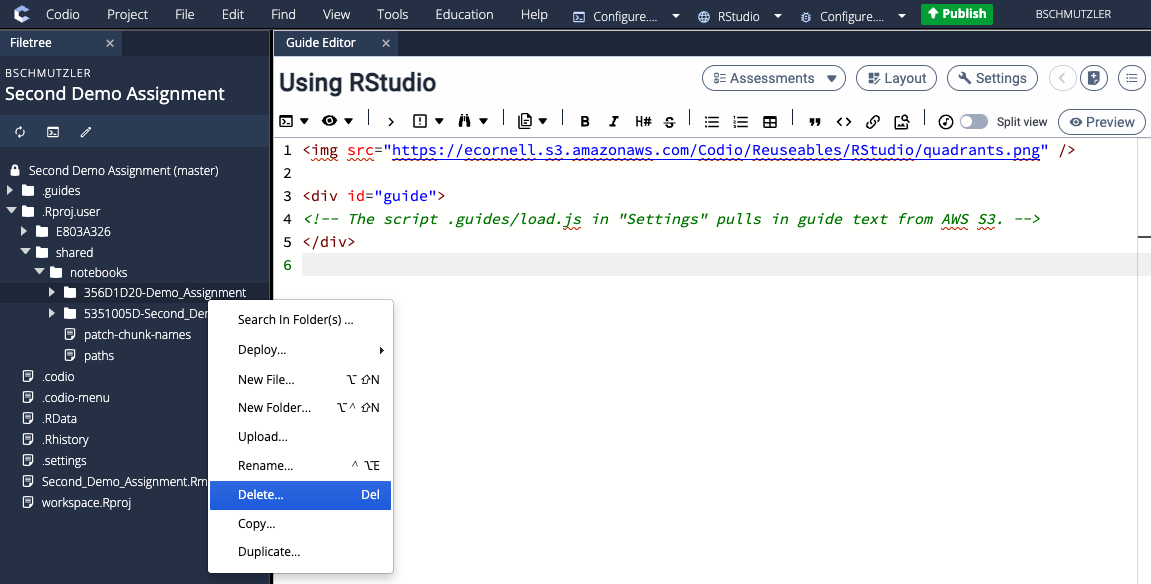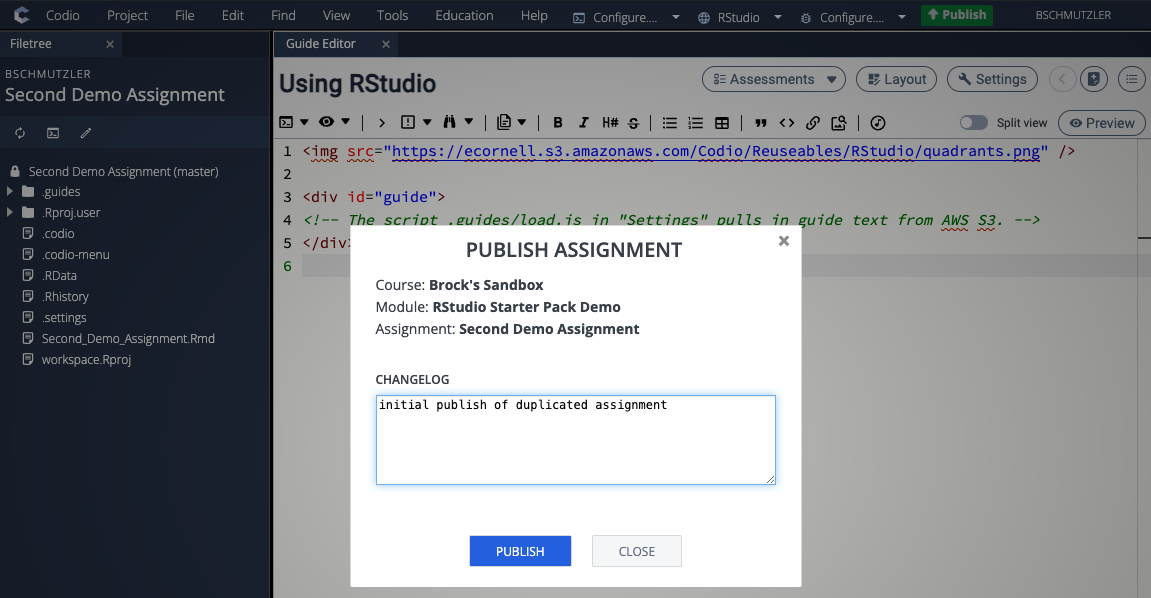Departmental Standards
Company-Wide
eCornell Styleguide & Branding
Cornell University Branding
Writing and Editing Style Guide
Faculty and Expert Naming Conventions in Courses
Cornell School and Unit Names
Tips for Campus Engagements
LSG
Legal Policies
CSG
Updating Wrike Due Dates
Photography Style Guide
eCornell Mini Visual Style Guide
The Pocket Guide to Multimedia Design Thinking (*as It Pertains to Your Job Here)
Creative Services (CSG) Handbook
Administrative
LSG Meeting Recordings and Notes
Sending Faculty Sign-Off Forms in Adobe Sign
Weekly Faculty Status Emails
Animation/Motion Design
Instructional Design
Required Course Elements
The Pocket Guide to Instructional Design Thinking at eCornell
Adding AER to Canvas
Grading
D&D Newsletter
LSG Newsletter (LSGN) - February 2024
LSG Newsletter (LSGN) - March 2022 Edition
LSG Newsletter (LSGN) - December 2023
LSG Newsletter (LSGN) - October 2021 Edition
LSG Newsletter (LSGN) - June 2022 Edition
D&D Newsletter November 2024
LSG Newsletter (LSGN) - August 2022 Edition
LSG Newsletter (LSGN) - June 2023
LSGN Newsletter April 2023
LSG Newsletter (LSGN) - February 2022 Edition
LSG Newsletter (LSGN) - October 2022 Edition
LSGN Newsletter February 2023
LSGN Newsletter March 2023
D&D Newsletter September 2024
LSG Newsletter (LSGN) - August 2023
LSG Newsletter (LSGN) - March 2024
LSG Newsletter (LSGN) - April 2022 Edition
D&D Newsletter - August 2024
LSGN Newsletter January 2023
LSG Newsletter (LSGN) - October 2023 article
LSGN Newsletter (LSGN) - April 2024
LSG Newsletter (LSGN) - November 2021 Edition
D&D Newsletter February 2025
LSG Newsletter (LSGN) - January 2022 Edition
LSGN Newsletter December 2022
D&D Newsletter April 2025
LSG Newsletter (LSGN) - July 2022 Edition
LSG Newsletter (LSGN) - September 2022 Edition
Course Development
Image Uploads for Inline Projects
How to Install the Firefox Canvas Utilities Extension
Revising a Course/ Creating a Redux Version/ Course Updates
Creating a Perma Link With Perma.cc
Course Content Deletion Utility — Removing All Course Content
Teleprompter Slide Template
Course Names
Requesting High Resolution Video Uploads
Technical Talking Points Template
Writing Discussions: Guidelines for IDs
Online Resources in Credit-Bearing Courses
Hiring Actors for an eCornell Project
Marketing
Operations
Tech
Master Course Template Differences (8675309s)
Non-CSG File Uploads
Mentored Learning Conversion Process and Resources
Doc-Based Master Course Template and Standards (8675309-DOC)
Pedagogical Guidelines for Implementing AI-Based Interactives: AER
Coding Master Course Template and Standards (8675309-CODE)
Practice Quiz Standards
Hero Image
Platform Training
Administrative Systems
ADP
Google Drive
Downloadables Process
Embed a Document from Google Drive
Adding Google Links to Canvas
File Naming and Storage Convention Standards
Google Drive for Desktop Instructions
Storing Documents in Multiple Locations
Wrike
Wrike System Fundamentals
Field Population
1.0 to 2.0 Wrike Project Conversion
Blocking Time Off in Work Schedule (Wrike)
Wrike Custom Field Glossary
Wrike "Custom Item Type" Definitions
How to Create a Private Dashboard in Wrike
Using Timesheets in Wrike
Importing Tasks into a Wrike Project
Wrike Project Delay Causes Definitions
Setting OOO Coverage for Roles in Wrike
How to Change a Project's Item Type in Wrike
Using Search in Wrike
How to Create a Custom Report in Wrike
@ Mentioning Roles in Wrike
Automate Rules
Using Filters in Wrike
Managing Exec Ed Programs in Wrike
External Collaborators
Wrike for External Collaborators: Getting Started
Wrike for External Collaborators: Views
Wrike for External Collaborators: Tasks in Detail
Wrike Updates
New Experience Update in Wrike
Wrike Course Development Template 2.0 - What's New
Wrike - Course Development Template 3.0 Release Notes
Wrike Process Training
Course Development & Delivery Platforms
Canvas
Development
Adding Custom Links to Course Navigation
Adding Comments to PDFs from Canvas Page Links
Setting Module Prerequisites and Requirements in Canvas
Canvas Page Functionality
Create a New Course Shell From 8675309
Using LaTeX in Canvas
Search in Canvas Using API Utilities - Tutorial
Reverting a Page to a Previous Version
Student Groups
Create Different Canvas Pages
Importing Specific Parts of a Canvas Course
Canvas HTML Allowlist/Whitelist
Understanding Canvas Customizations/Stylesheets
Operations
Discussion Page Standards
How to import a CU course containing NEW quizzes
Canvas LMS: NEW Quiz compatibility
Faculty Journal
Course Content Style Guide
Click-To-Reveal Accordions in Canvas
Course Maintenance Issue Resolution Process
Meet the Experts
Codio
Codio Operations
Managing Manually Graded “Reflect and Submit” Codio Exercises
Codio Structure and Grading for Facilitators
Premade Codio Docs for Ops & Facilitators
Codio Remote Feedback Tools for Facilitators
Developers
Development Processes
Creating a New Codio Course
Creating a New Codio Unit
Integrating a Codio Course into Canvas
Embedding a Codio Unit into Canvas
Setting Up the Class Fork
Jasmine Autograde Unit Testing
Setting Up the Class Fork (LTI 1.3)
R Studio - Exclusion List for R Code
Mocha/Selenium Autograding
Starter Packs in Codio
Configuring Partial Point Autograders in Codio
Launch a Jupyter Notebook from VM
AI Extensions
Program-Specific Developer Notes
Codio Functionality
Jupyter Notebooks
Jupyter Notebooks - nbgrader tweaks
Jupyter Notebooks Style Guide
Adding Extensions to Jupyter Notebooks
Setting up R with Jupyter Notebooks
Change Jupyter Notebook Auto Save Interval
How to Change CSS in Jupyter Notebook
RStudio in Codio
How To Centralize the .codio-menu File to One Location
Codio Fundamentals for LSG
Using the JupyterLab Starter Pack
Using Code Formatters
Using the RStudio Starter Pack
Conda Environments in Codio
Updating Codio Change Log
Codio Basics: Student Support
eC Facilitator Guide to Codio
Migrating to Updated Codio Courses
Qualtrics
Ally
Ally Institutional Report Training
Ally Features Overview Training
Using the Ally Report in a Course
Ally Vendor Documentation/Training Links
Adobe
Other Integrations
Pendo Overview
How to Add VitalSource eBooks in Canvas
Enabling Zoom/"Live Sessions" in a Course
Pendo Guide Creation
H5P
Modifying Subtitles in H5P Interactive Videos
Embedding H5P Content Into Canvas
Troubleshooting H5P Elements in Canvas
Inserting Kaltura Videos into H5P Interactive Videos
Adding Subtitles to H5P Interactive Videos
S3
BugHerd
Instructional Technologies & Tools Inventory
Canvas API Utilities
Getting started with the MOP Bot
eCornell Platform Architecture
HR & Training Systems
Product Development Processes
Accessibility
What Is Accessibility?
What Is Accessibility?
Accessibility Resources
Accessibility Considerations
Accessibility Support and Assistive Technology
Structural Accessibility
Accessibility Design and Development Best Practices
Accessible Images Using Alt Text and Long Descriptions
Accessible Excel Files
Accessibility and Semantic Headings
Accessible Hyperlinks
Accessible Tables
Creating Accessible Microsoft Files
Mathpix: Accessible STEM
Design and Development General Approach to Accessibility
Integrating Content Authored by a Third Party
Planning for Accessible Tools
Accessibility Considerations for Third Party Tools
Studio Accessibility
Designing for Accessible Canvas Courses
Accessibility: Ongoing Innovations
Course Development
Planning
Development
0. Design
1. Codio Units
1. Non-Video Assets
3. Glossary
4. Canvas Text
4. Tools
4. Tools - Wrike Task Definitions
3. Review And Revise Styled Assets
ID/A to Creative Team Handoff Steps
General Overview of Downloadables Process
Course Project: Draft and Final
Excel Tools: Draft and Final
eCornell LSG HTML Basics
1. Non-Video Assets - Wrike Task Definitions
2. Video
Multifeed Video
2. Video (Standard) - Wrike Task Definitions
Studio Tips
Tips for Remote Video Recording Sessions
Who to Tag for Video Tasks
3. Animation
3. Animation - Wrike Task Definitions
2. Artboard Collab Doc Prep
6b. Motion Design Review and Revise
Who to Tag for Animations Tasks
3. Artboard Collab Process Walkthrough
DRAFT - FrameIO Process Walkthrough
Motion Contractor Guide for IDAs / IDDs
Requesting / Using Stock Imagery (Getty Images and Shutterstock)
3. Ask the Experts
5. On-Demand Conversion
5. Review
5. Review - Wrike Task Definitions
1. Prep Course for Reviews
2. Conduct Student Experience Review
3. Implement Creative Director Edits
3. Implement IDD Edits
3. Implement Student Experience Review Edits
4. CSG - Revise Tools Export 1
5. Conduct Faculty Review
6. Implement Faculty Edits
7. Conduct Technical Review of Course (STEM-only)
Technical Student Experience (Tech SE) Review Process
2. Conduct IDD or Sr ID Review
6. Alpha
6. Alpha - Wrike Task Definitions
Alpha Review Process
Prepare a course for Alpha review
Schedule & Conduct Alpha Triage Meeting
7. QA
7. QA - Wrike Task Definitions
1. Prep Course for QA
2. Copy Edit Captions
2. Copy Edit Course & Files
4. Conduct Content QA of Course
4. Final Creative Review and Export
Adding Chat With Tech Support to Course Navigation
5. Implement QA Edits
Working With Video Captions That Contain Special Characters
Copy Edit Captions in SubPLY
Creating a Course Style and Settings Guide
Copy Editing Content in Frame.io
1. Complete Dev to QA Checklist
Copy Edit Captions in 3Play
Tag a Video for Transcription by 3Play
Course QA Checklists
8. Deployment
8. Deployment - Wrike Task Definitions
1. Finalize Master Version of Course
2. Create & Add Course Transcript (CT) to Course
Replace a Master -M With a Redux Version of the Course
3. Create -T (Training Course) and Associate With Master Blueprint
Canvas Blueprint Course Functionality
Project Management in Wrike
Managing Project Reporting in Wrike
Managing Task Needs/Schedule in Wrike
Adding Tasks
Comments and Communication
Statuses
Updating Task Start and Due Dates
Predecessors
Durations
Rollups
Calculating Project Schedule by Deadline in Wrike
Creating Course Project Plans in Wrike
Setting Custom Capacity for Resources
Customizing Effort in a New Project Plan
Marking Projects Complete in Wrike
How to Set Up Workload Charts to Track Effort in Wrike
For-Credit Considerations
1-Sheet Population
Post-Development
Program Facilitation & Operational Guidelines
Data Science
Facilitator Resources
Canvas Navigation
Adding Events to the Course Calendar
Navigating Canvas and the Dashboard
How Do I View Previous Courses I Have Taken or Facilitated?
Why Am I Receiving Duplicate Canvas Emails?
How Do I Edit My Canvas Profile?
Send Students a Direct Message on Canvas
Adding Notes to Canvas Gradebook
How Do I Send Students Nudges from the Gradebook?
Overview of 2024 Changes- Course Layout and Structure
How Can I Update My Canvas Notification Preferences?
Ursus Navigation
How Do I Access My Offer in Ursus?
How Do I Edit My Ursus Profile?
How Do I Request Time Off (Blackout Dates)?
How Can I Request to Learn More Courses?
Live Sessions
When Should I Schedule My Live Sessions For?
Changing Live Session Date and Time After Created with Facil Tool
Help! I Need to Reschedule a Live Session
Live Session Information page
Set up Live Sessions with the Facil Tool
Combining Live Sessions with Facil Tool
Course Set-Up
Course Set Up: Getting Ready for Live Sessions
Recording and Posting a Welcome Video
Course Set Up: When can I begin to edit my course?
Course Set Up: Reviewing Due Dates
Course Set Up: Reviewing Announcements
What Do I Need to Do to Make Sure My Course is Set Up Correctly?
How Do I Customize My Course Sections?
Course Announcements and Messages Templates
Facilitator Focus
Zoom and other Technical Support
Reporting Spam/Phishing
How Do I Set Up My Zoom Account?
Support Resources for Facilitators
Live Session/Zoom Trouble Shooting Guide & Technical Readiness
How to Upload Videos to Zoom On-Demand
Student Survey FAQs
How Do I Save and Refer Back to Zoom Recordings?
How Do I Find My Personal ID Meeting link in Zoom?
Benefits as an eCornell Employee
Do I Have Access to Microsoft Office as a Cornell Employee?
Taking Courses as a Student
Professional Development Benefit
Student Success
Help! My Students Can't View a Video Within My Course
Extensions and Retakes
Policies and Navigation Resources for Students
Symposium Access Extension- Fall 2025
Students enrolled through special groups: Corporate and VA
Unique Circumstances for Student Extensions and Retakes
Communicating with Students via Canvas
Can I Provide Students with a Letter of Recommendation?
Understanding and Addressing Instances of Plagiarism
Support Resources for Students
Understanding and Addressing Use of AI
Help! My Student is Having a Hard Time Uploading a Video
Unique Student Situations
I Have a Student Requesting Accommodations- How Should I Proceed?
Canvas Mobile App
Messaging Students via the Canvas Mobile App
Setting up and Navigating the Canvas Mobile app
Setting up Push Notifications on Canvas Mobile
Canvas App Features for eCornell courses
New Facilitator Onboarding and Quick References
Facilitator Onboarding at eCornell
Why Do I Have Multiple eCornell email and Canvas Accounts?
Quick reference: Systems and Accounts we use at eCornell
Quick reference guide: Key eCornell Personnel
How do I Log Onto Canvas and Access FACT101?
How Do I Add eCornell to My Email Signature?
Training Course Review & Facilitation Authorization
What to Expect During Live Shadowing Experience
Setting up Email Forwarding
Facilitator Expectations and Grading Help
Changes in Grading Scheme: Incomplete/Complete and 75% to 85%
New (Embedded/Inline Format) How do I grade Course Projects?
Navigating the Gradebook and Accessing the Speedgrader
Quick Reference: Sort assignments in the Speedgrader
How do I Grade Quizzes?
(Old format) How Do I Grade Course Projects and Add Annotations?
Rubrics for Effective Facilitation
Is There an Answer Key for my Course?
How to Monitor and Promote Student Progress
How Do I Grade Discussions?
Adding an Attempt to a Course Project
How Quickly Do I Need to Provide Grading to Students?
Payroll and the Monthly Scheduling Process
Codio References
Manually Graded “Reflect and Submit” Codio Exercises
Codio Quick Resources
Codio Reference: Embedded quiz questions (H5P)
Codio Reference: Checking for Completion Status
Codio Reference: Manually Graded Exercises
Codio Remote Feedback Tools
Codio Reference: Ungraded exercises
Codio Reference: Autograded Exercises
Archived
Table of Contents
- All Categories
- Platform Training
- Course Development & Delivery Platforms
- Codio
- Developers
- Codio Functionality
- Using the RStudio Starter Pack
Using the RStudio Starter Pack
Updated
by Brock Schmutzler
RStudio is an integrated development environment (built by Posit) that eCornell uses for many courses with coding projects in R. Specifically, eCornell uses an open-source version of RStudio Server hosted by Codio and installed via the Tools > Install Software utility (available from the Codio menu within each Codio unit).
Creating Codio Assignments
The easiest way to create a Codio assignment with an RStudio environment is to use eCornell's RStudio Starter Pack because it has "starter files" pre-loaded in Codio's workspace, in addition to running eCornell's JupyterLab and RStudio stack called Ubuntu 22.04 + JupyterLab + RStudio (built from the Codio-certified JupyterLab stack for Ubuntu 22.04 LTS). The JupyterLab and RStudio stack includes several Python packages (e.g., numpy, pandas, seaborn) and R packages (e.g., ggplot2, tidyverse) that are commonly used for data science projects. The RStudio Starter Pack files are stored in /home/codio/workspace, whereas the JupyterLab and RStudio stack is saved at the /home/codio level.
To use eCornell's RStudio Starter Pack, add a new Codio assignment by following these steps:
- Select Add assignment > New
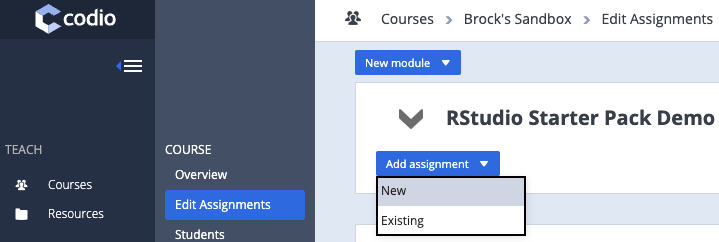
- Select the Starter Pack option as your starting point and then click browse
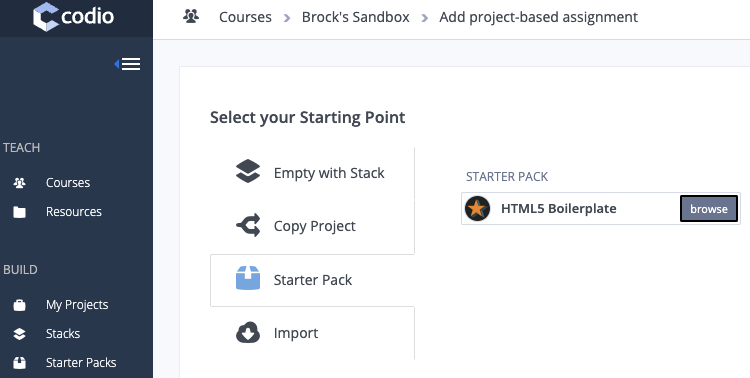
- Search All starter packs for "RStudio Starter Pack"

- Change your assignment name appropriately and then click Create
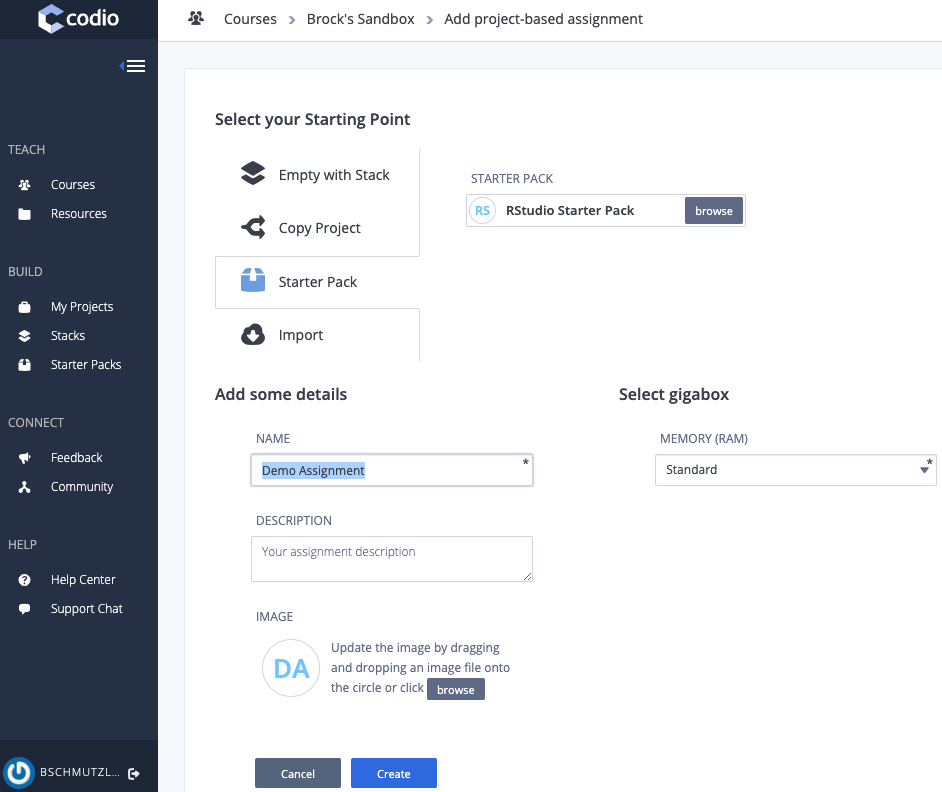
Adding R Markdown Files
After creating a new assignment (or opening an assignment that has already been created), you will be taken to a screen that looks something like this:
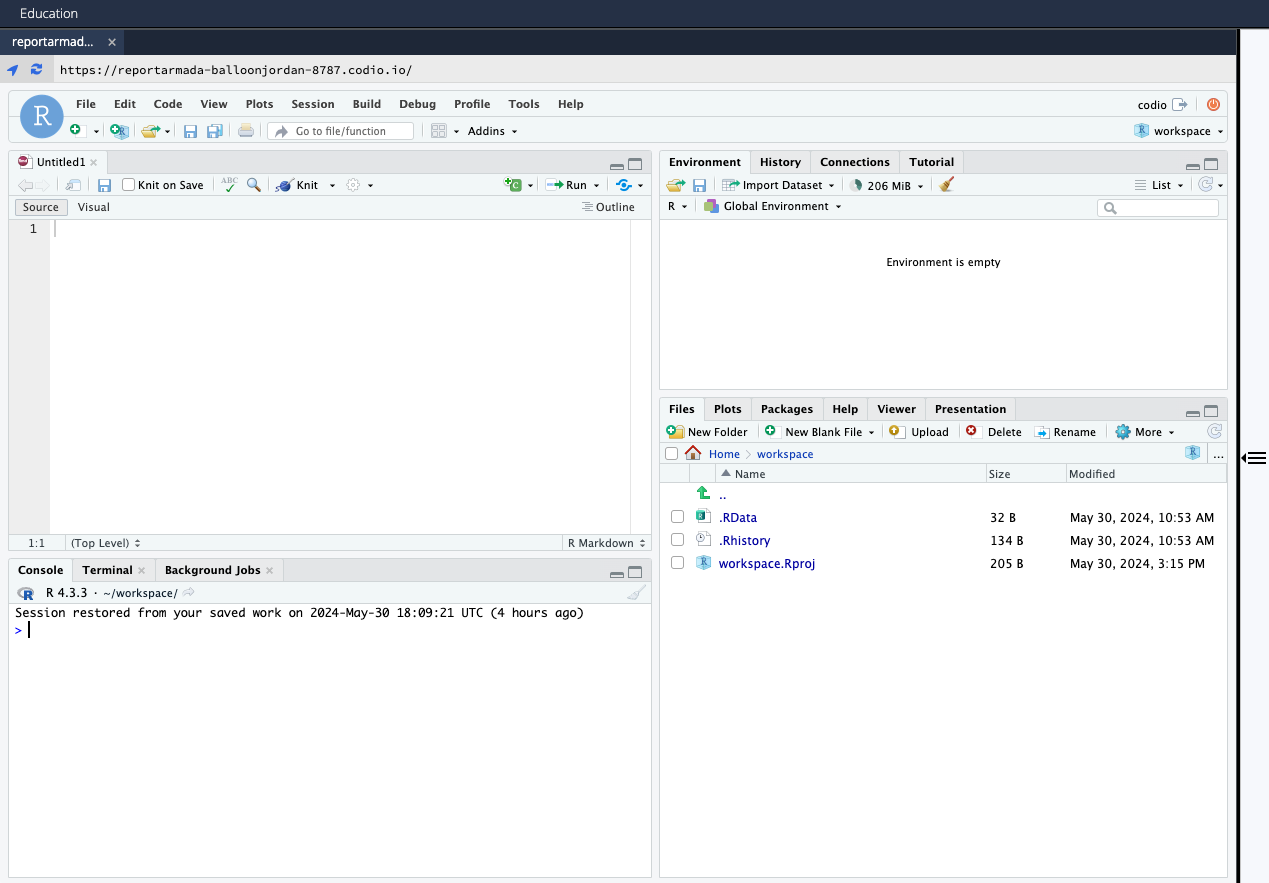
To add the contents of an R Markdown file for the Codio assignment:
- Copy and paste the contents of your R Markdown file into the
Untitled1.Rmdfile in the source panel: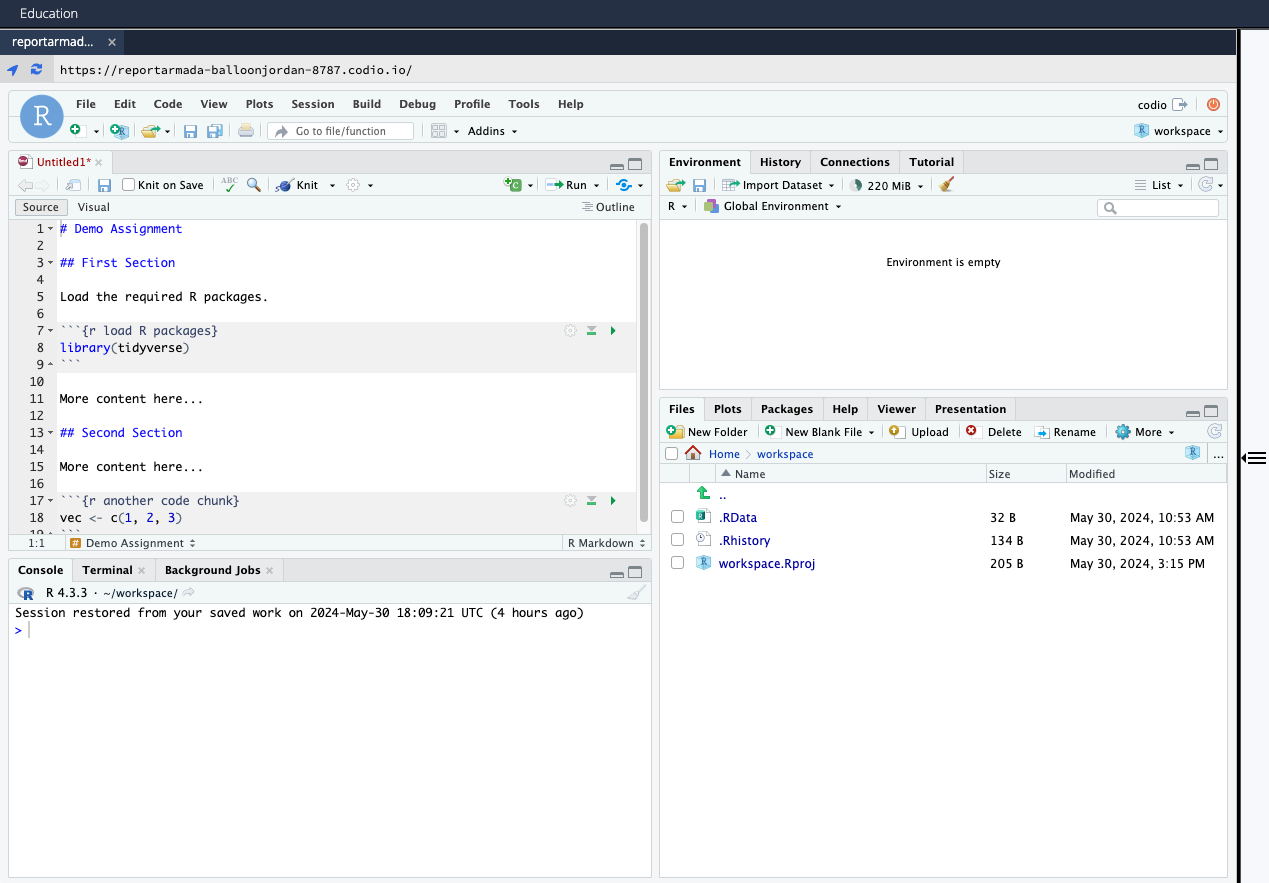
- Click File > Save in the RStudio menu
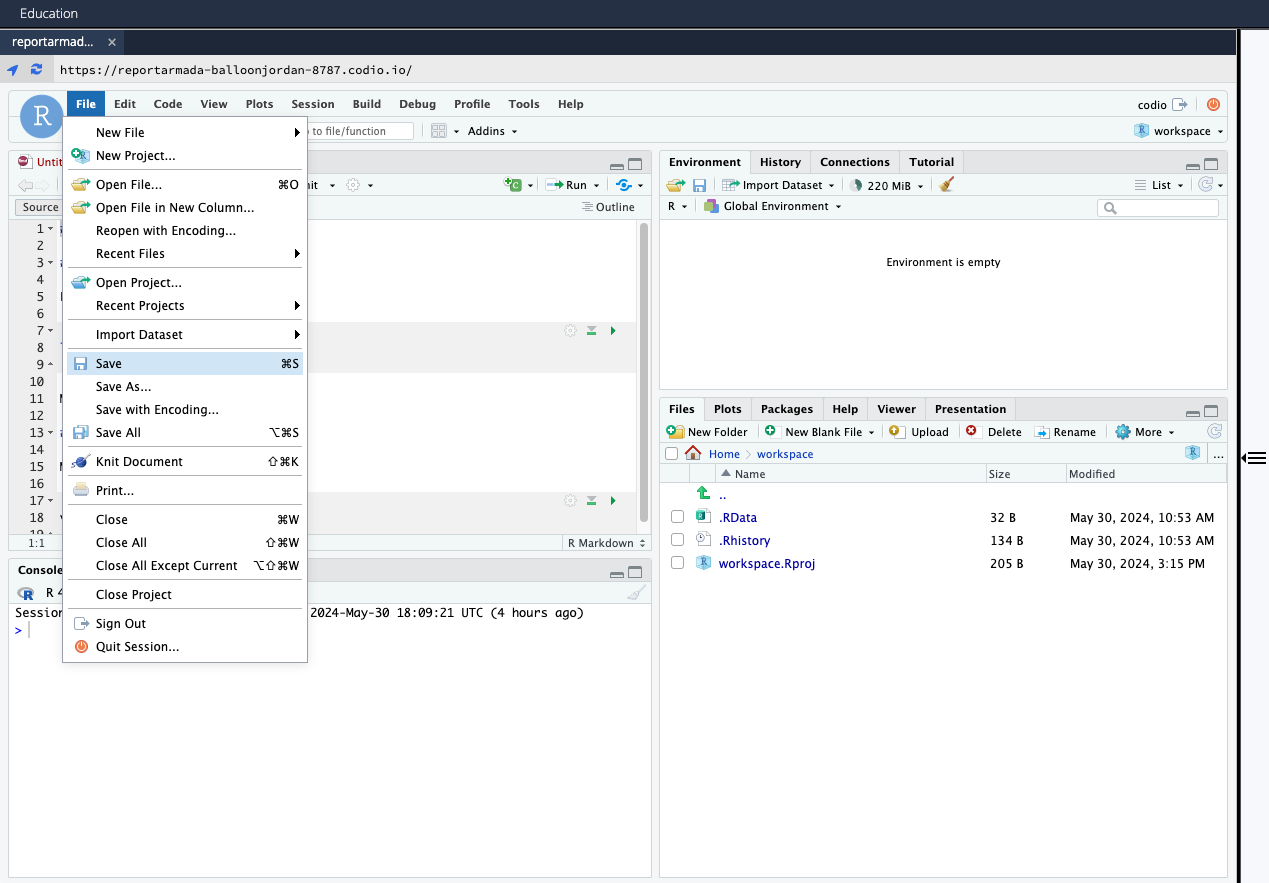
- Give your R Markdown file an appropriate name (e.g.,
Demo_Assignment.Rmd) and click Save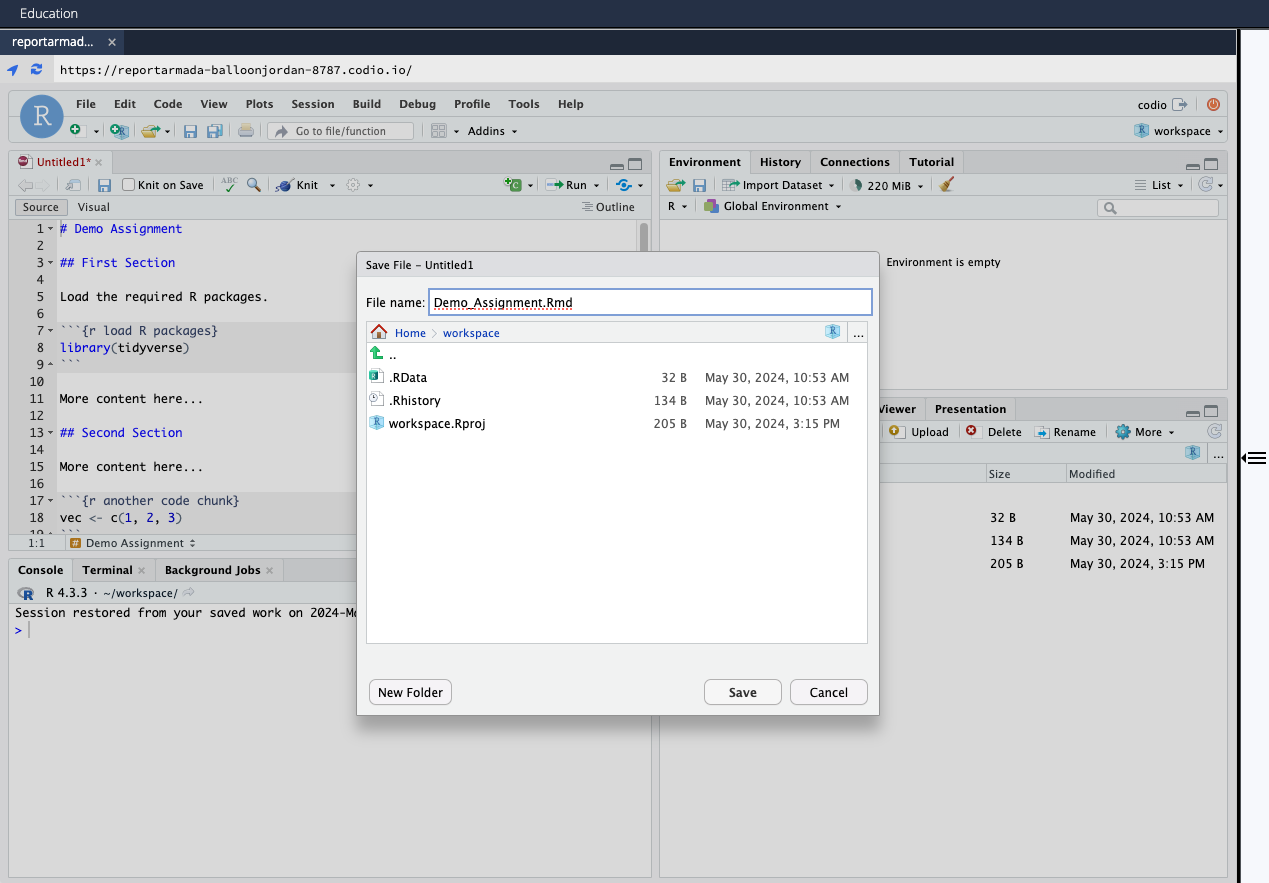
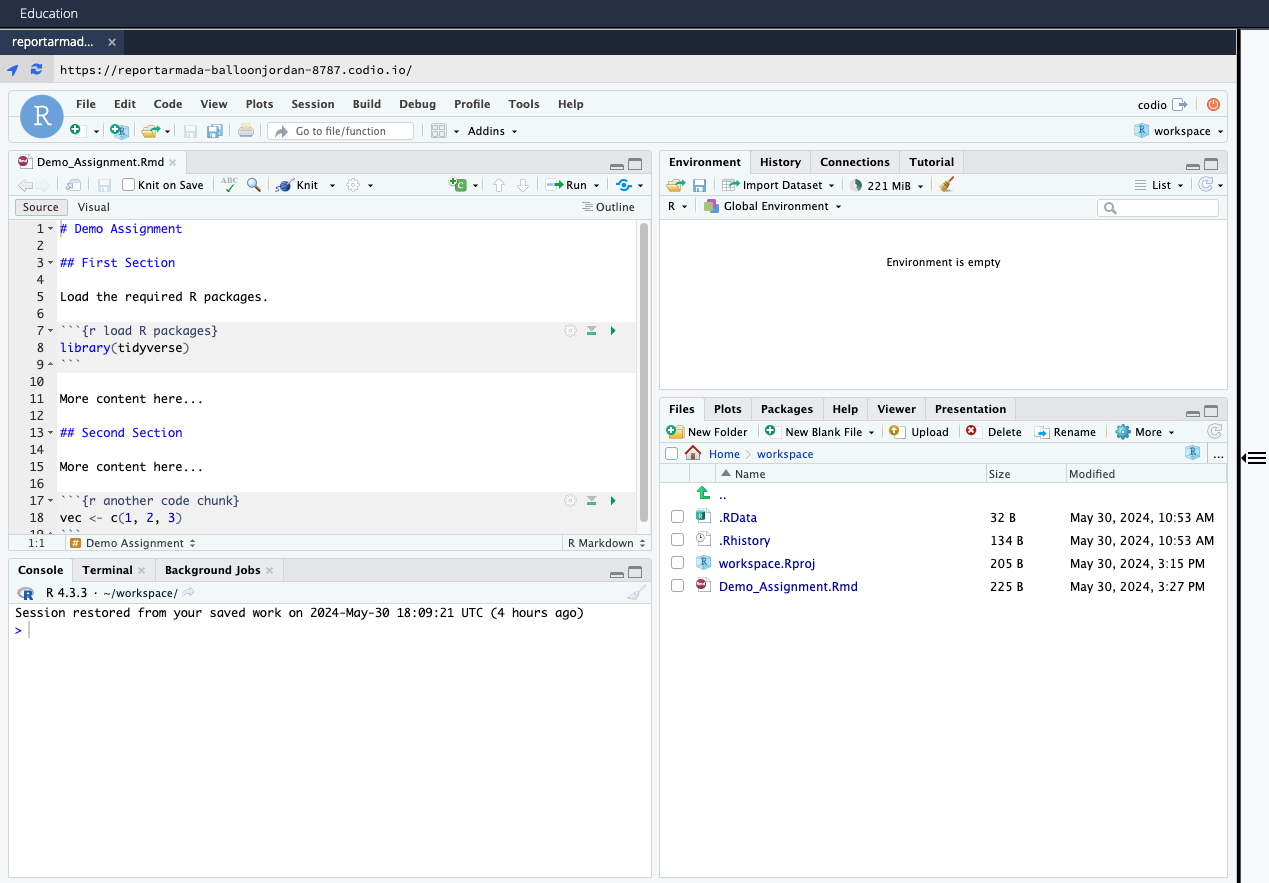
- Select Education > Publish Assignment from the Codio menu, write a descriptive note in the CHANGELOG, and click PUBLISH. When you see that the publish was successful, click RETURN TO DASHBOARD.
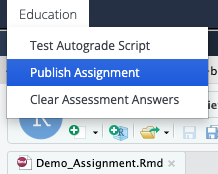
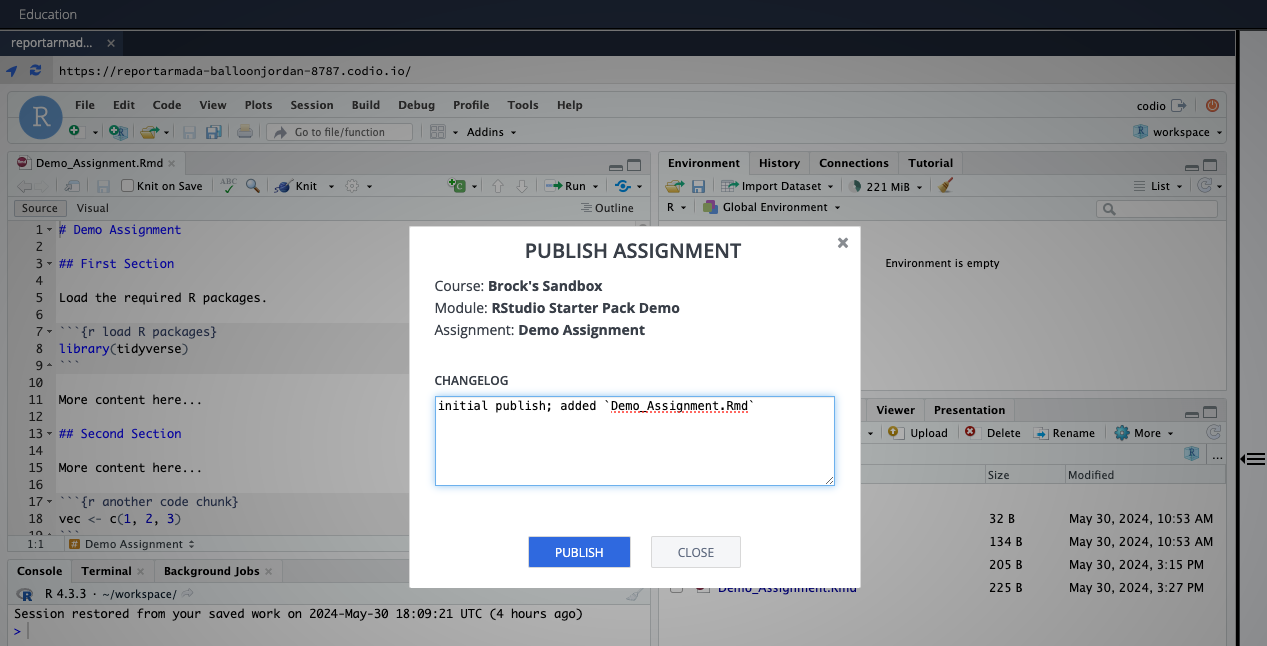
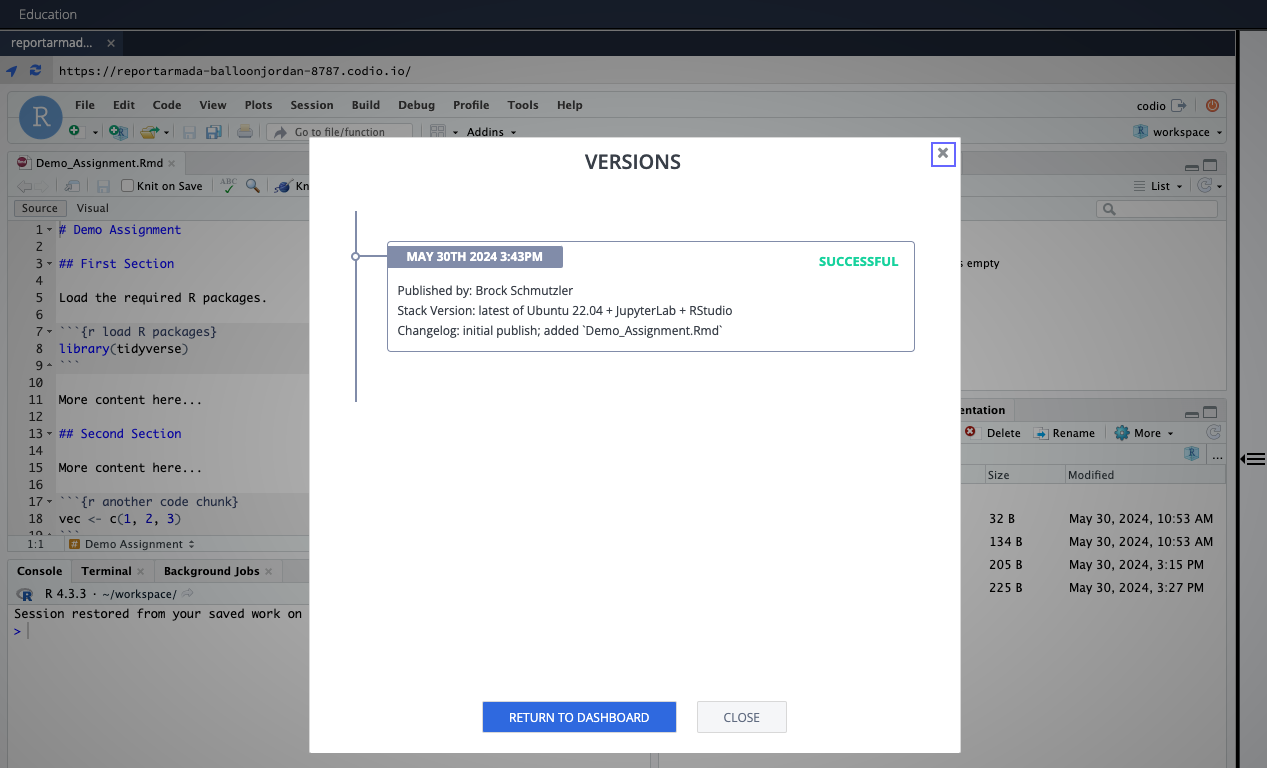
Creating New Stacks
When you create an assignment using the RStudio Starter Pack, the assignment comes with an underlying stack called Ubuntu 22.04 + JupyterLab + RStudio. Since each series of courses should have its own stack, it is important to create a new stack for your courses by following the steps below. Before reading the steps below, please take heed of the following warning:
- Go to Project > Stack > Create New...
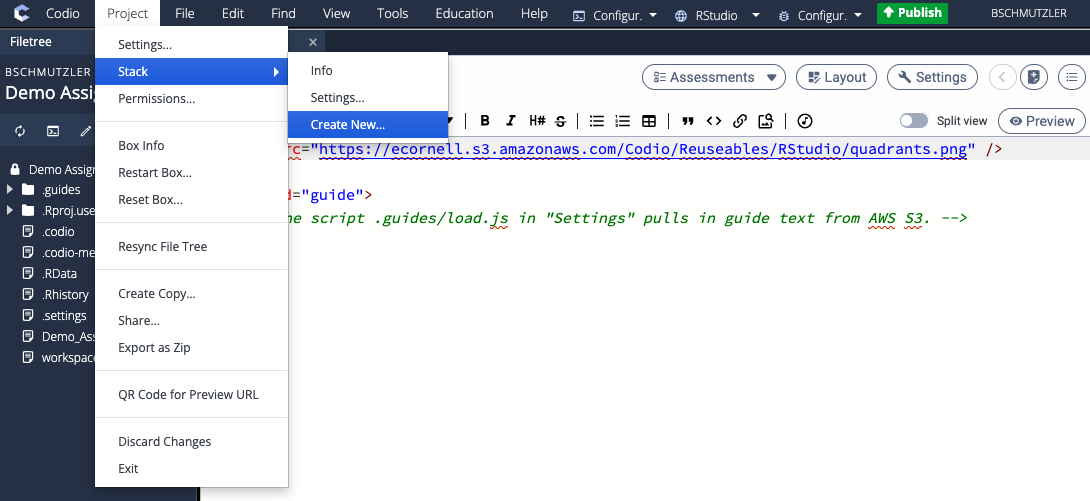
- Make sure New Stack is selected, give your stack a name that matches the series of courses (e.g., DEMO120s Stack), select Public, and make eCornell the owner
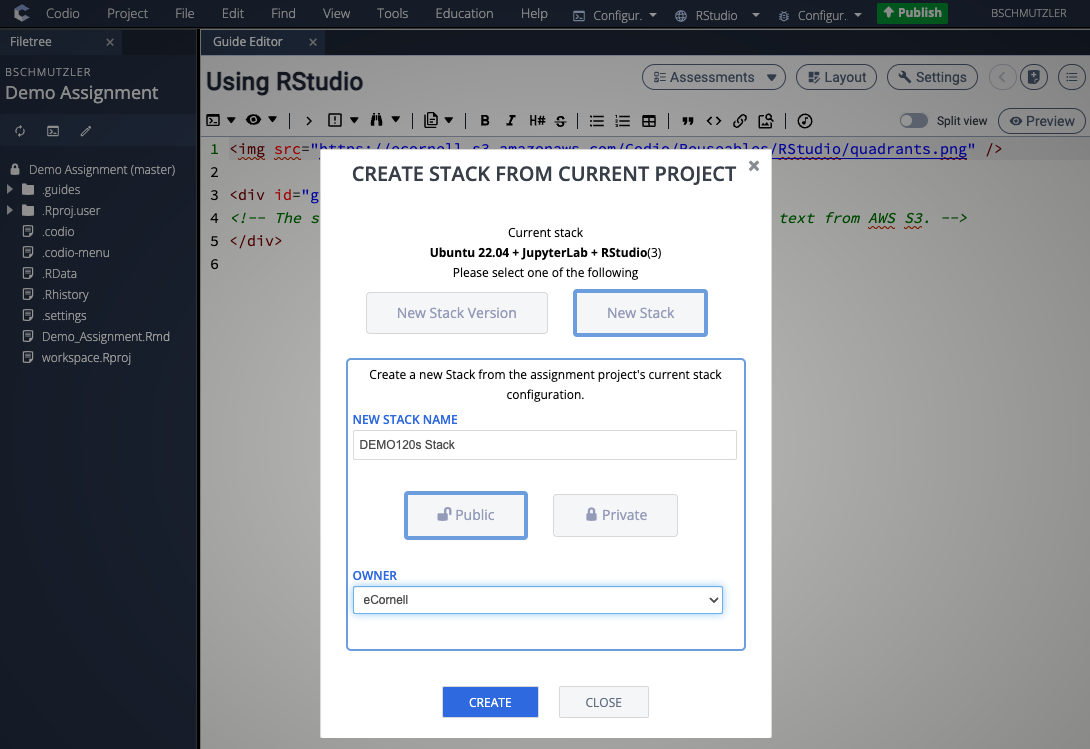
- Click CREATE and click YES when prompted with the CHANGE STACK CONFIRMATION dialog box. After clicking YES, you should see a message saying Stack build in progress. If you receive a strange error message, click CREATE again and the stack build should begin this time.
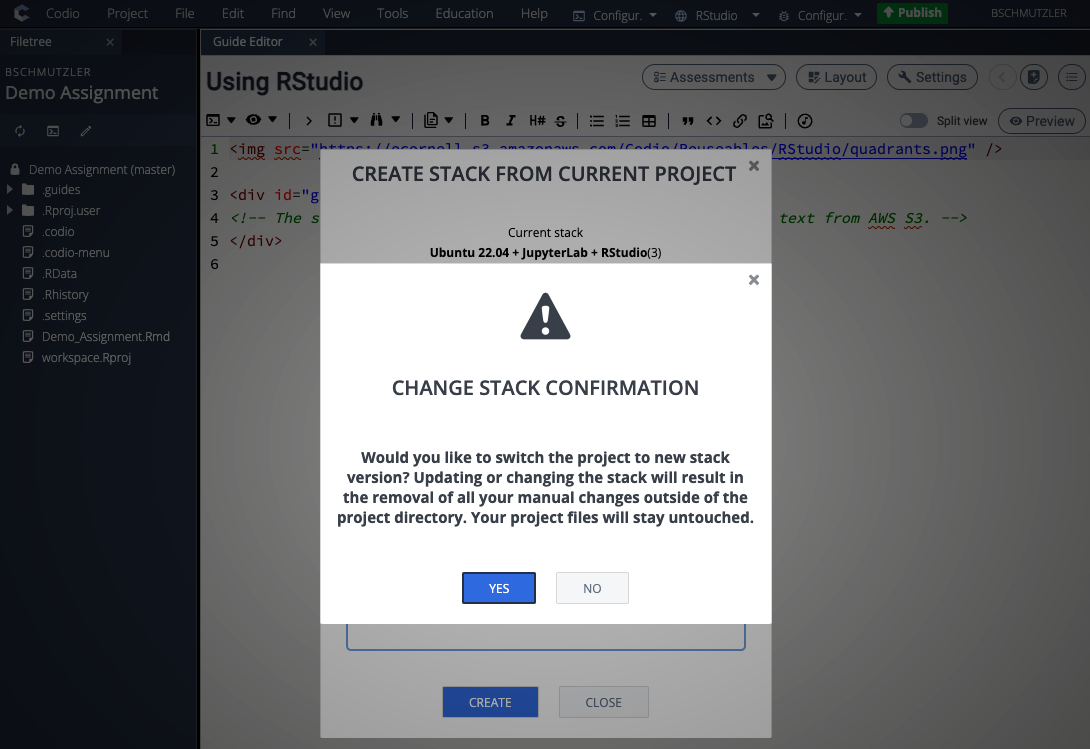
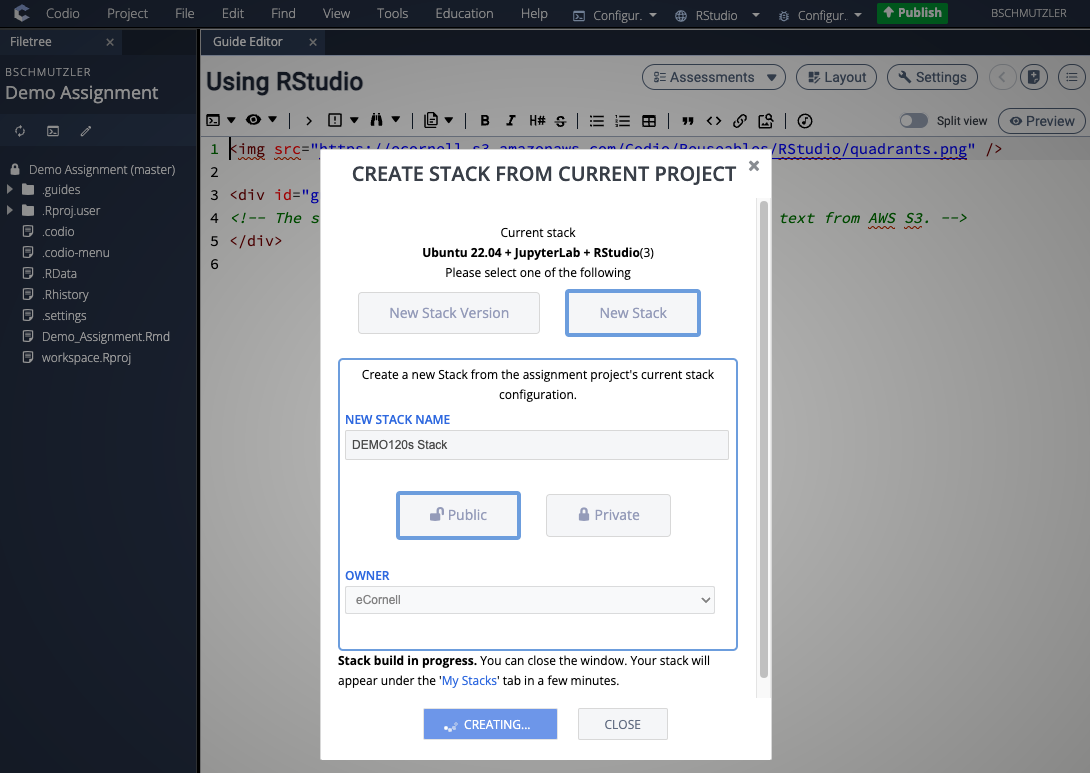
- After your stack has been created, go to Project > Stack > Settings... to make sure the assignment is using the new stack you created. If your new stack is the CURRENT STACK for your assignment, proceed to step 6. If the CURRENT STACK for your assignment is still Ubuntu 22.04 + JupyterLab + RStudio, complete step 5 before going to step 6.
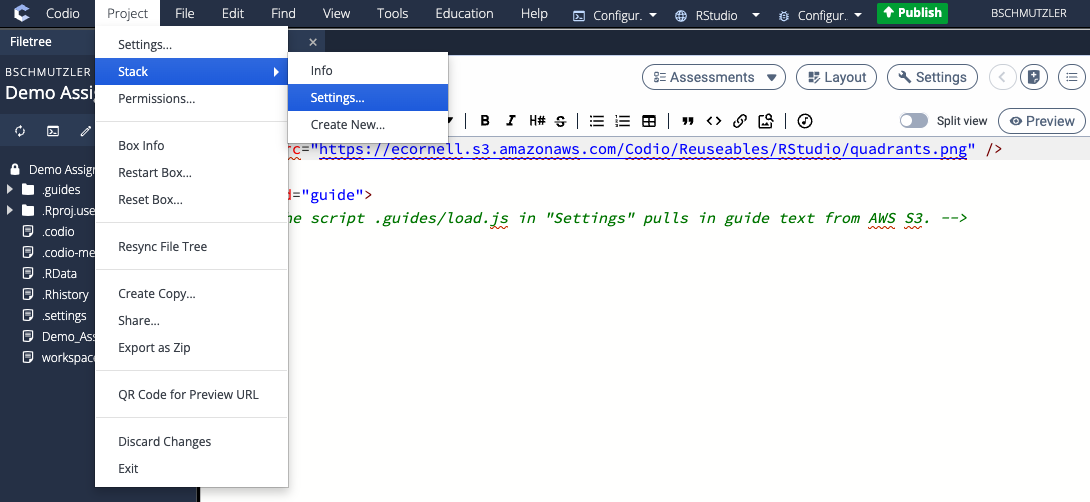
- If the CURRENT STACK for your assignment is not the new stack you created, make sure you change the CURRENT STACK to your new stack before installing or updating any software. After changing the CURRENT STACK to your newly created stack, proceed to step 6.
- Click the drop-down menu to search for your new stack
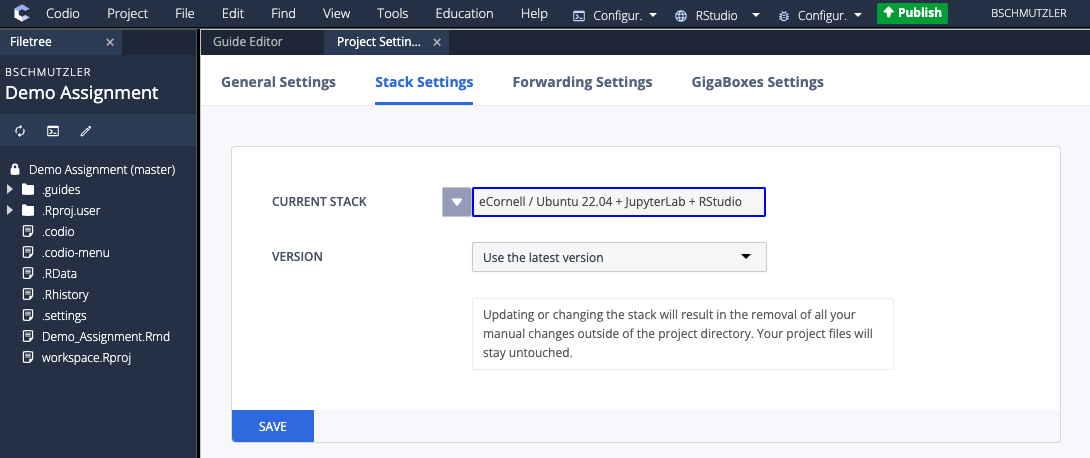
- Search for your new stack (e.g., DEMO120s Stack)
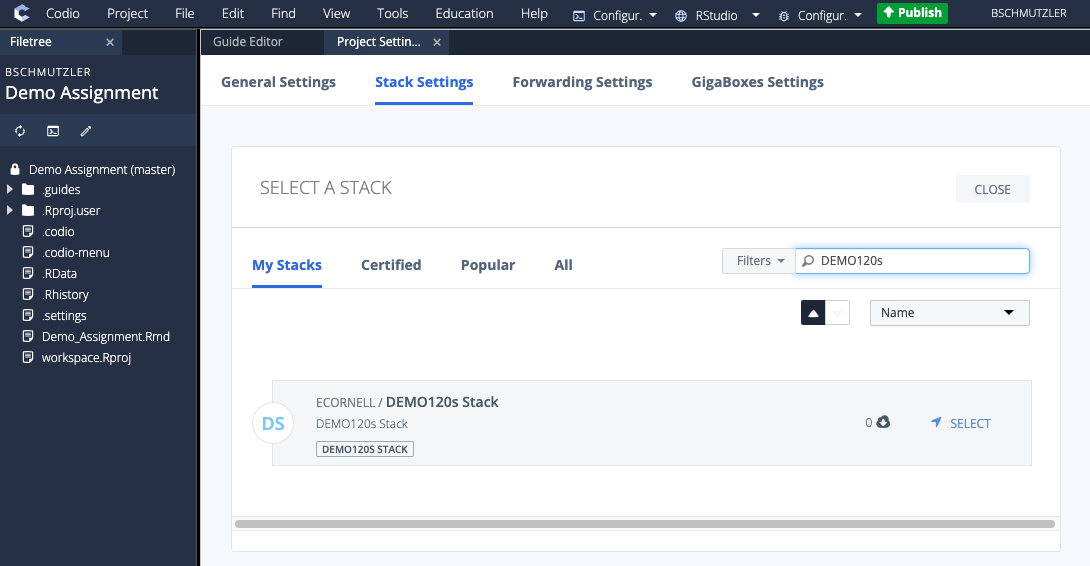
- Select your new stack (e.g., DEMO120s Stack) and click SAVE
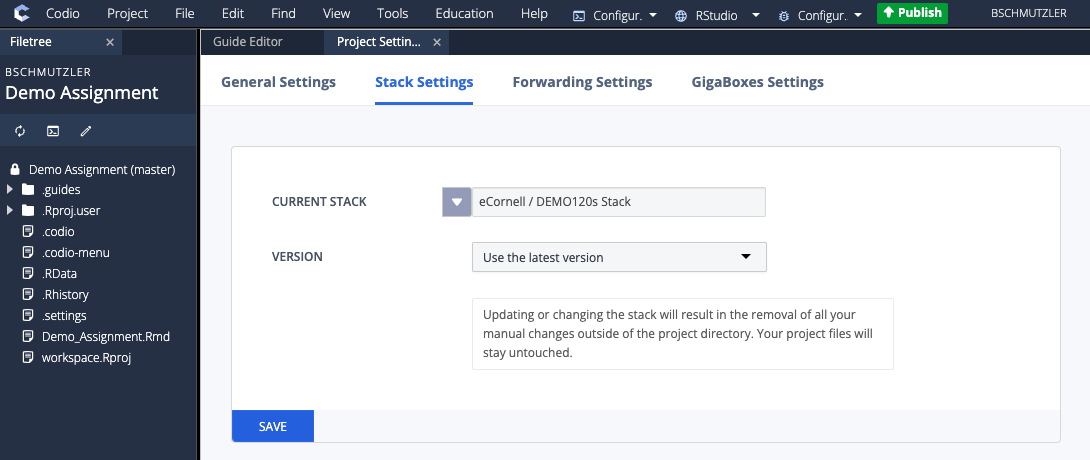
- Confirm the stack change by entering the confirmation code in the CHANGE STACK CONFIRMATION dialog box and reload your browser after you receive a message saying Stack updated successfully
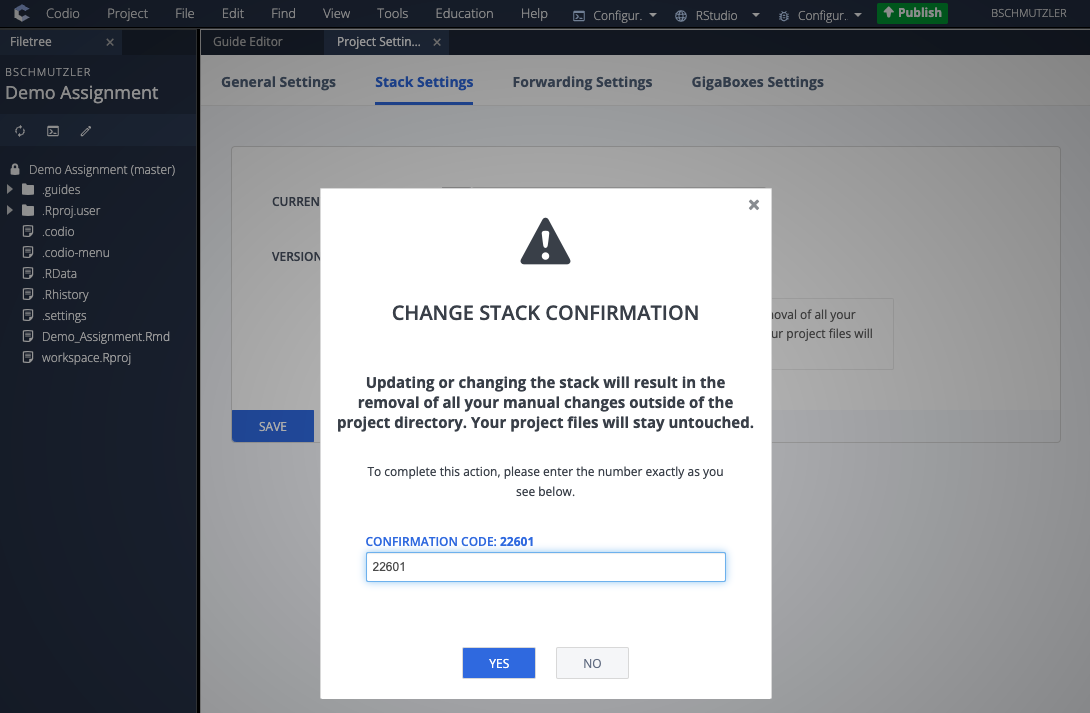
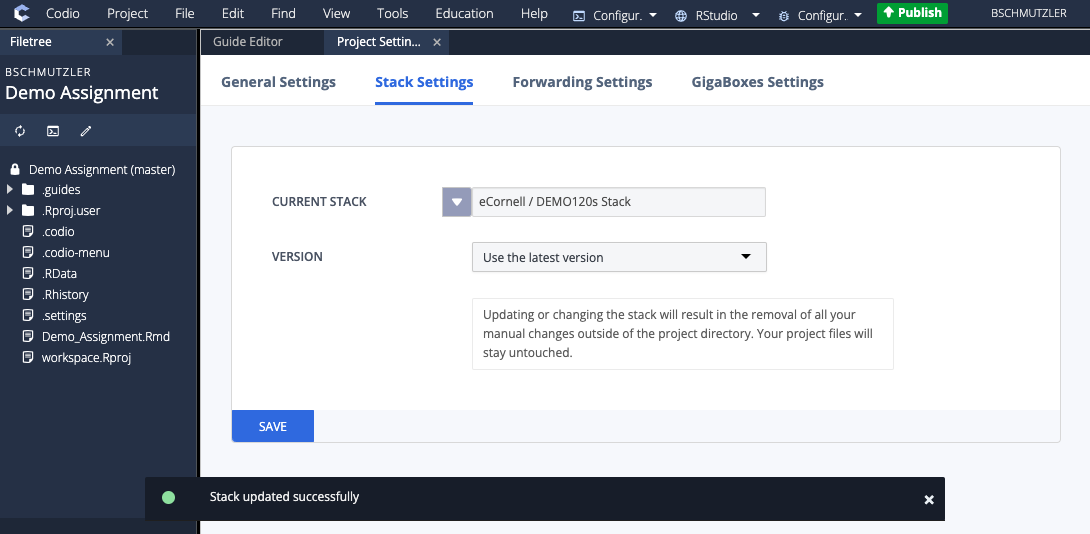
- Click the drop-down menu to search for your new stack
- Update and/or install software on your new stack and then create a new version by going to Project > Stack > Create New... and selecting New Stack Version. Make sure to write a concise and descriptive CHANGELOG entry.
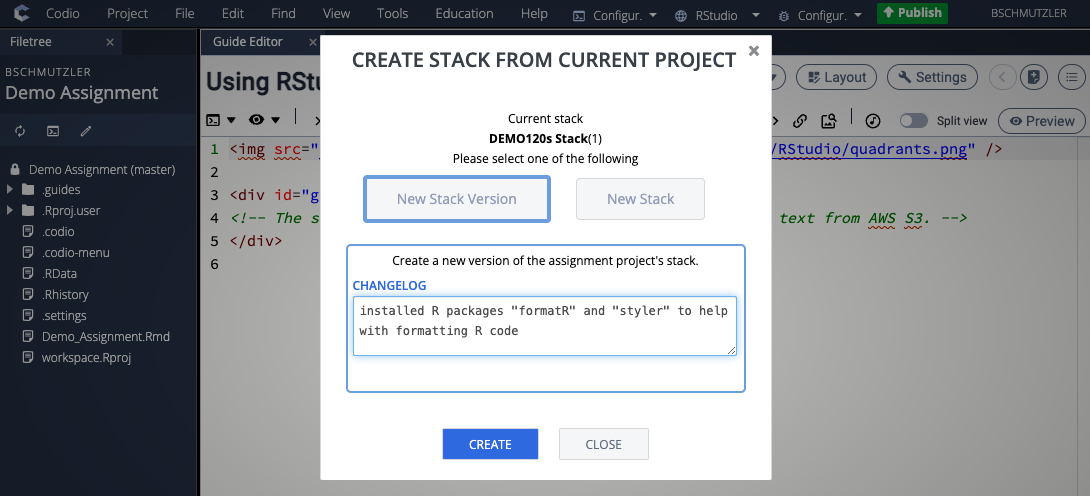
- Go to Project > Stack > Settings... to confirm that a new stack version has been created and make sure that VERSION is set to Use the latest version
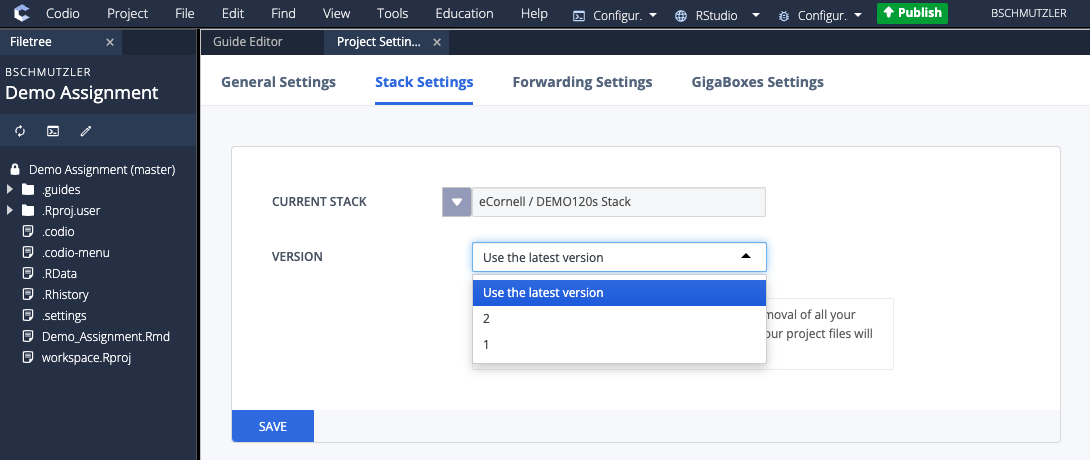
- Publish your assignment with the new stack version and write a concise and descriptive CHANGELOG entry. It may take a few minutes for the publishing process to complete and return a SUCCESSFUL message.
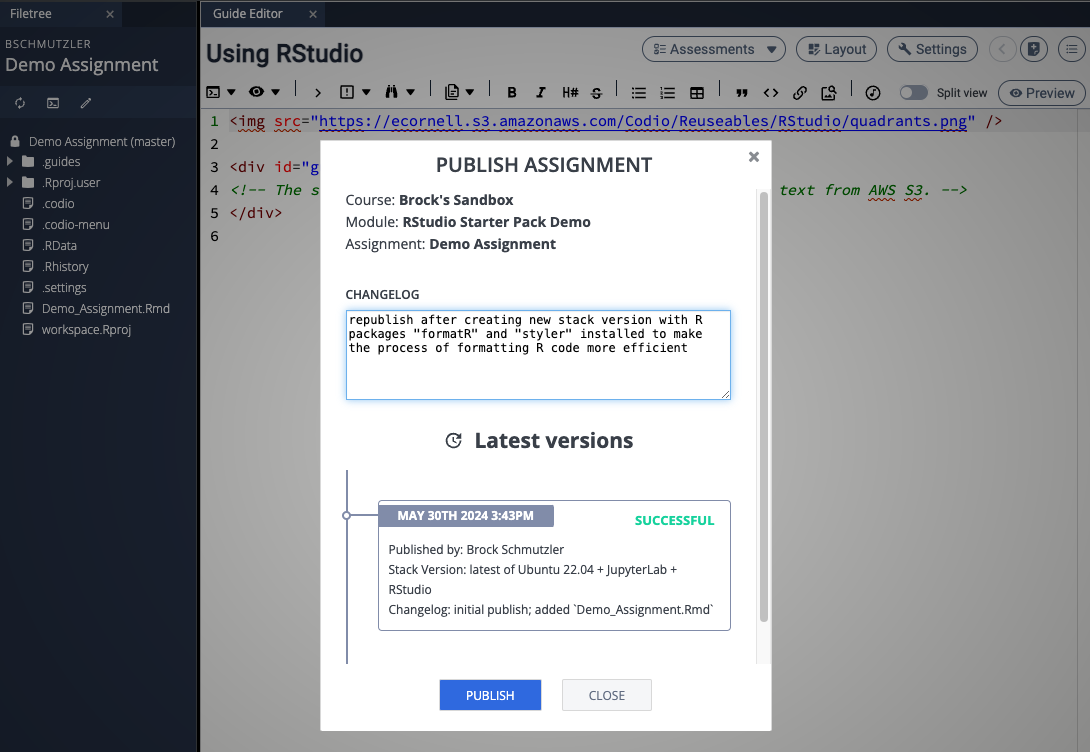
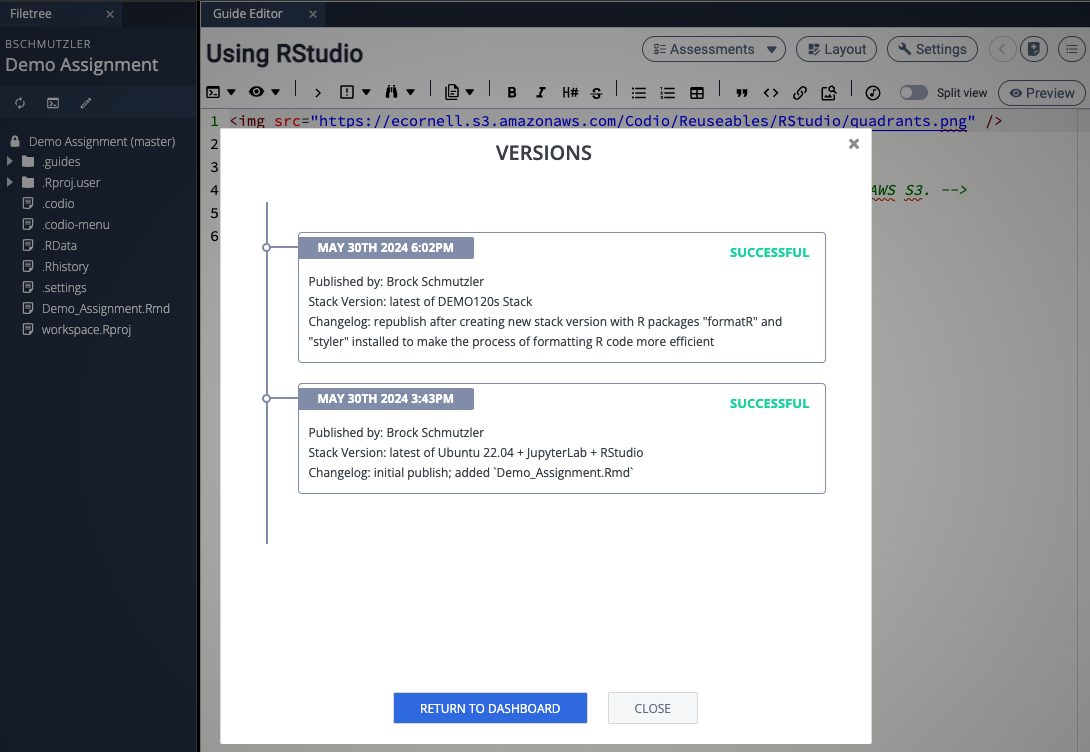
Configuring Workspace Starter Files
The starter files in /home/codio/workspace are:
.guides/load.js.guides/styles.css.codio.codio-menu.settings
For most use-cases, you will not need to modify any of these files. However, if you need modified versions for a specific course, high-level instructions are provided in the subsections below. When in doubt, please contact a member of the Instructional Technologies Group (ITG) for assistance.
.guides/load.js
The file .guides/load.js is a script that pulls guide text from AWS S3. It looks like this:
$("#guide").load("https://ecornell.s3.amazonaws.com/Codio/Reuseables/RStudio/guideText.txt");If you need to modify the text on the collapsable Guide page, copy the text file guideText.txt from the S3 folder Codio/Reusables/RStudio and put a modified version in a folder on S3 that is specific to your series of courses and replace the link in load.js — e.g.,
$("#guide").load("https://ecornell.s3.amazonaws.com/Codio/Courses/DEMO120s/guideText.txt");guideText.txt file in the S3 folder Codio/Reusables/RStudio because those changes will propagate to ALL courses whose guide text is linked to that file. The only people allowed to modify Codio/Reuseables/RStudio/guideText.txt are members of the Instructional Technologies Group (ITG). Please contact ITG if you find a typo or believe the text should be changed..guides/styles.css
The file .guides/styles.css imports a CSS stylesheet from S3:
@import "https://ecornell.s3.amazonaws.com/Codio/CSS/styles.css";
The stylesheet Codio/CSS/styles.css controls the look of HTML elements in the Codio guide and is common to most Codio units developed by eCornell.
styles.css file in the S3 folder Codio/CSS because those changes will propagate to ALL courses linked to that file. In the unlikely scenario that you need to include additional styling elements, you can add them below the import statement in the .guides/styles.css file for your course-specific Codio units..codio
The .codio file contains code that configures the RStudio preview button that appears in the Codio menu bar across the top of your screen:
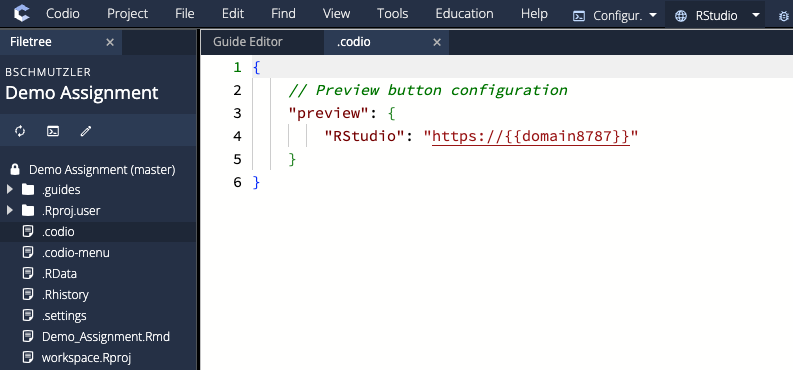
As shown in the image above, the contents of .codio look like this:
{
// Preview button configuration
"preview": {
"RStudio": "https://{{domain8787}}"
}
}Clicking the RStudio preview button opens an instance of RStudio while you are in Edit mode:
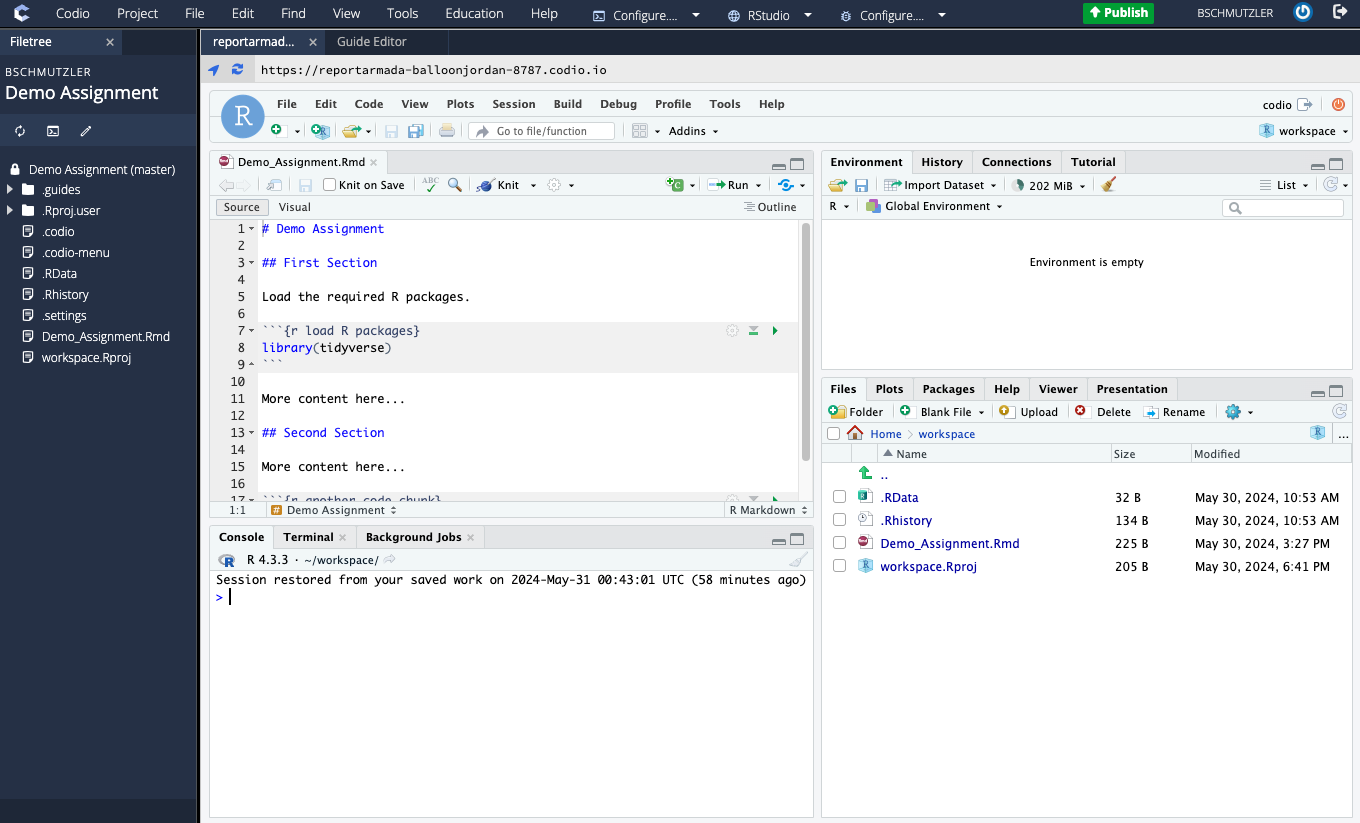
Note that this RStudio preview tab in Edit mode is the same as what you see when you are in Preview mode (i.e., when you click the Preview button in the upper-right corner of the Guide Editor tab):

Preview mode shows you what the Codio unit will look like when it is embedded in Canvas.
.codio-menu
The .codio-menu file controls which menu options are shown to students in Canvas:
{
"Logo": false,
"Codio": false,
"Project": {
"Restart Box...": true,
"Resync File Tree": false,
"Export as Zip": false,
"Settings...": false,
"Stack": false,
"Permissions...": false,
"Box Info": false,
"Reset Box...": false,
"Create Copy...": false,
"Share...": false,
"QR Code for Preview URL": false,
"Delete...": false,
"Exit": false
},
"File": false,
"Edit": false,
"Find": false,
"View": false,
"Tools": false,
"Education": {
"Mark as Completed": true,
"Code Comments": false,
"Earsketch": false,
"Jupyter Lab": false
},
"Help": false,
"Run": false,
"Debugger": false,
"Status": false,
"Preview": false,
"Toggle sections list": false,
"Online": false
}The configuration that comes with the RStudio Starter Pack only shows the options Project > Restart Box... and Education > Mark as Completed in the top Codio menu bar. This is typically all that is needed for a Codio unit using RStudio because all student work is done within the RStudio environment.
If no auto-grading is necessary and facilitators will not be reviewing the work (e.g., in an ungraded practice activity), you can disable the Education > Mark as Completed button in the ASSIGNMENT settings (Overview > Settings) by toggling on the option DISABLE MARK AS COMPLETED (make sure to click the Save Changes button afterwards):
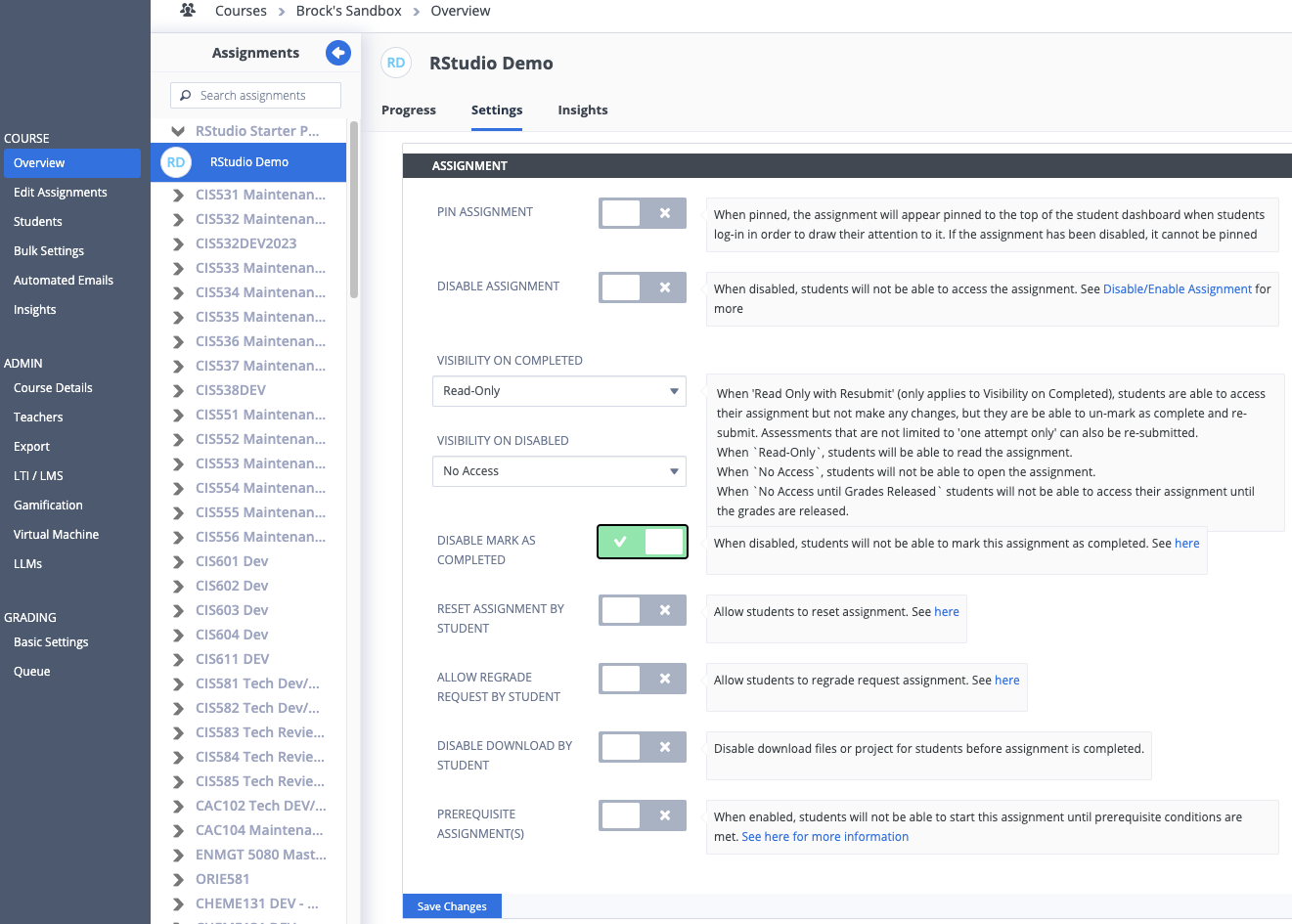
If you need to expose more Codio menu options to students, you can follow these steps:
- Copy Codio/Reuseables/RStudio/guideText.txt
- Add
codio-menu.txtto a course-specific S3 folder (e.g.,/Codio/Courses/DEMO120s) - Modify the content of your course-specific
codio-menu.txtfile as needed - Modify the file
/home/codio/startup.shas directed in How to Centralize the .codio-menu to One Location (steps 3b, 4b, and 5) - Create a new course-specific stack version (DO NOT create a new version of Ubuntu 22.04 + JupyterLab + RStudio)
For example, here is a .codio-menu.txt file that would also expose the Project > Export as Zip menu option:
{
"Logo": false,
"Codio": false,
"Project": {
"Restart Box...": true,
"Resync File Tree": false,
"Export as Zip": true,
"Settings...": false,
"Stack": false,
"Permissions...": false,
"Box Info": false,
"Reset Box...": false,
"Create Copy...": false,
"Share...": false,
"QR Code for Preview URL": false,
"Delete...": false,
"Exit": false
},
"File": false,
"Edit": false,
"Find": false,
"View": false,
"Tools": false,
"Education": {
"Mark as Completed": true,
"Code Comments": false,
"Earsketch": false,
"Jupyter Lab": false
},
"Help": false,
"Run": false,
"Debugger": false,
"Status": false,
"Preview": false,
"Toggle sections list": false,
"Online": false
}.settings
The .settings file controls the text editor settings of the Guide Editor. This file is automatically generated by Codio when the Guide is created — you will not need to make any changes to the .settings file.
Graded Canvas Assignments
Follow the steps in this section to set up a graded assignment in Canvas with an embedded Codio unit.
- Create a new Canvas assignment page
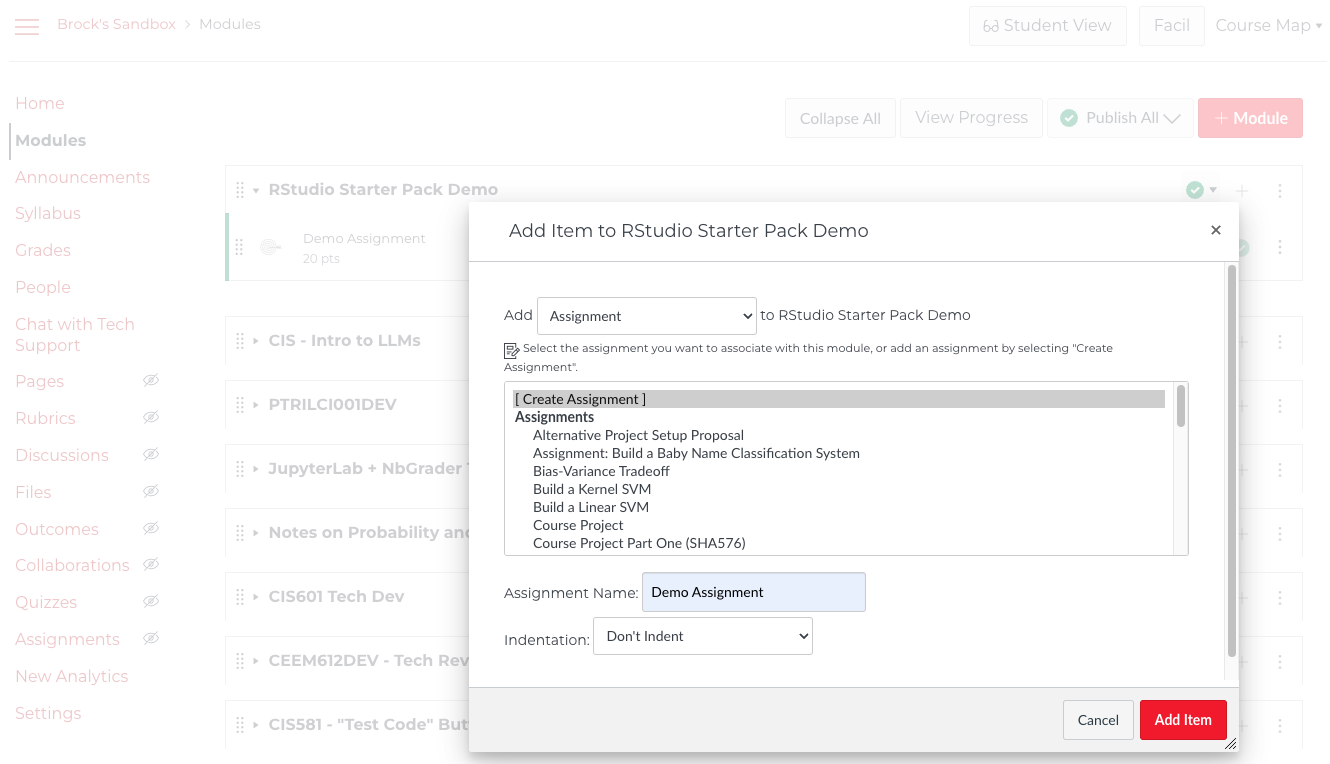
- Configure assignment settings
- Use External Tool submission
- Create Codio Projects group
- Display grade as Percentage
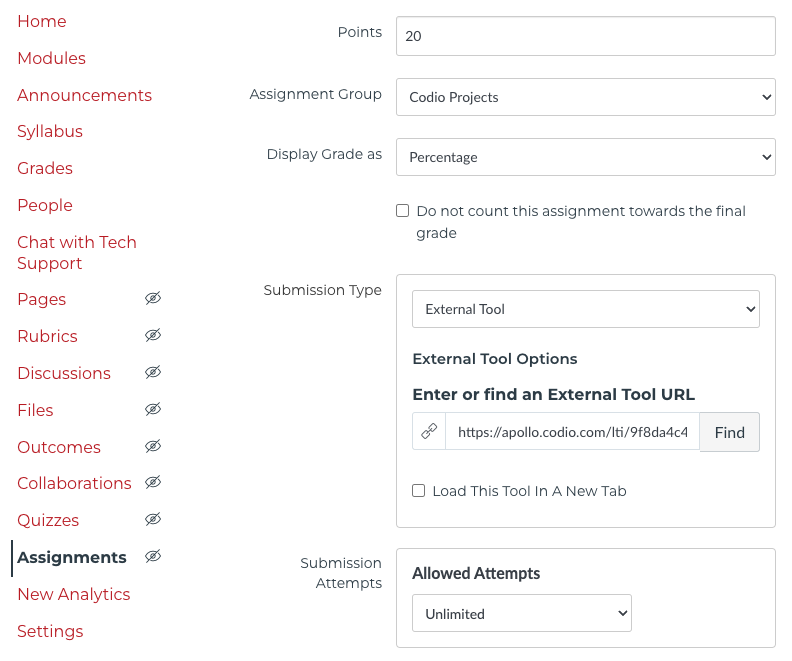
- Configure Codio assignment settings (make sure to Save Changes for each setting)
- Read Only with Resubmit
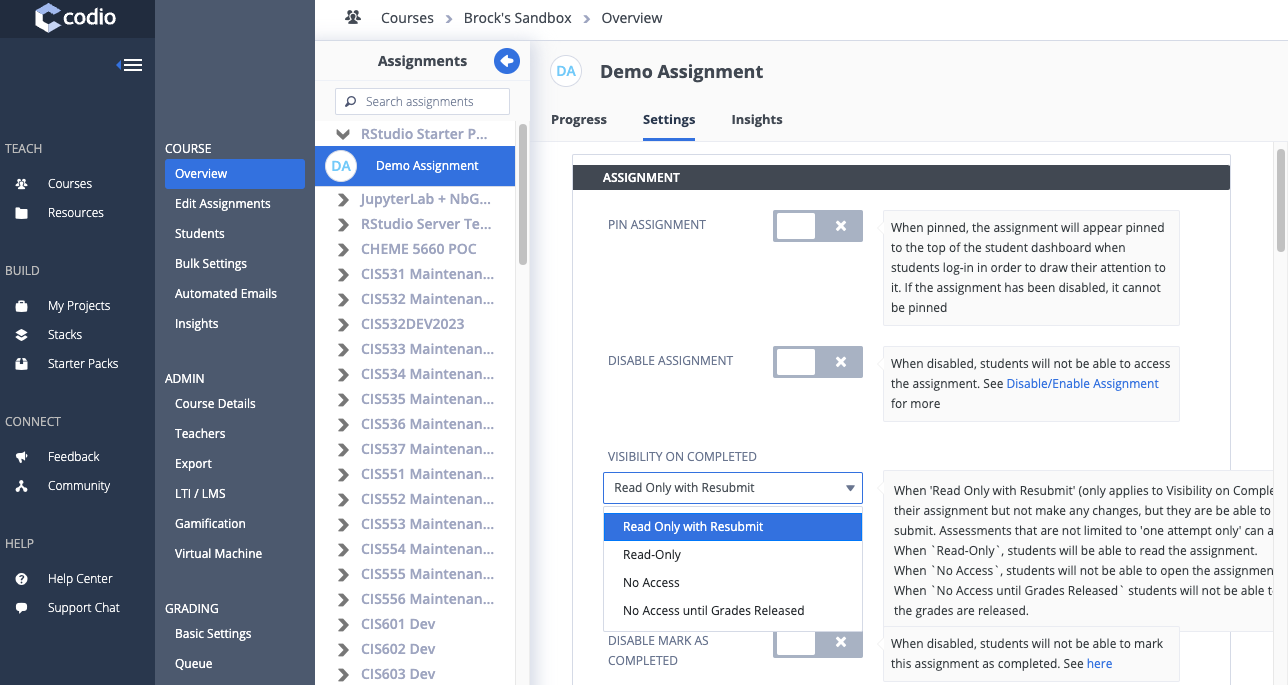
- TEACHERS GRADING (toggle off if the assignment is not graded)
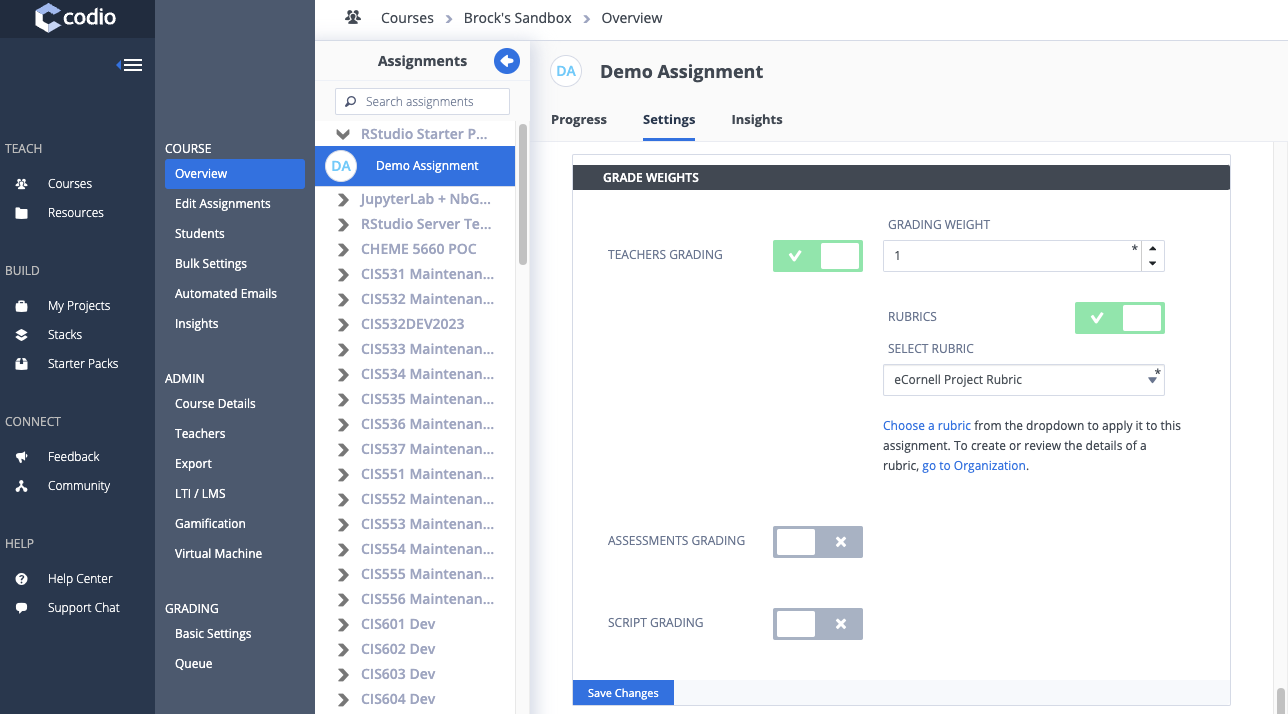
- Read Only with Resubmit
- Test in Student View
- Enter any solution code and run all cells to make sure no errors or warnings are raised
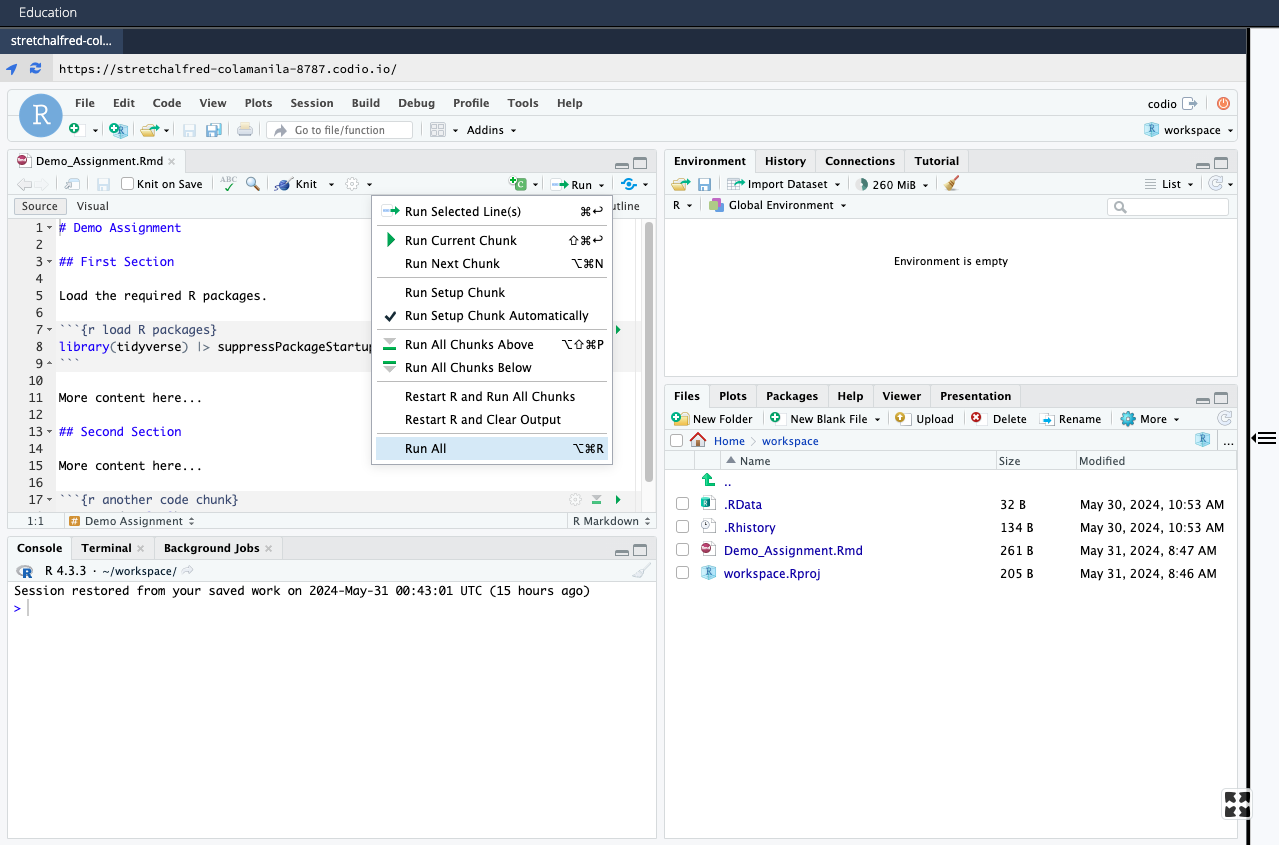
- Save your changes by pressing
command+S - Go to the Education menu and select Mark as Completed

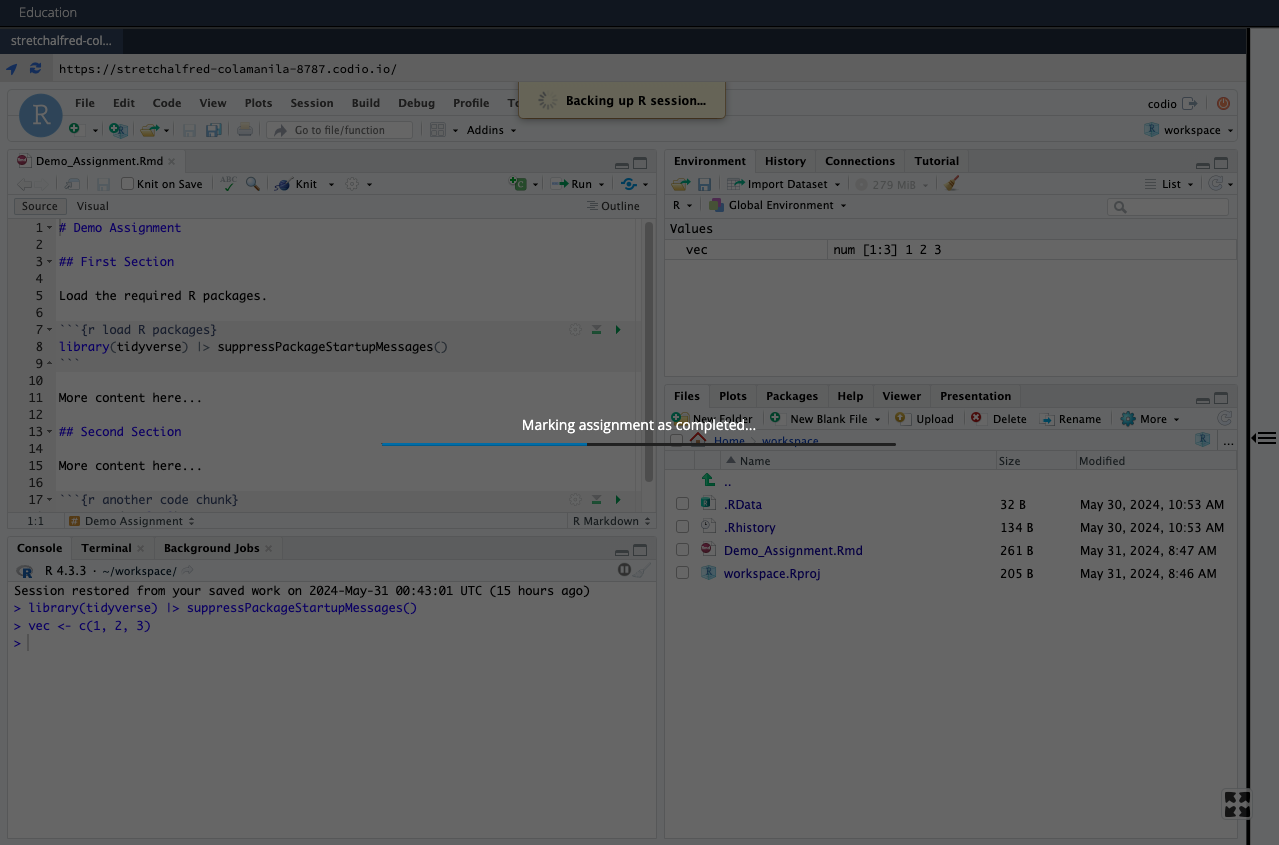
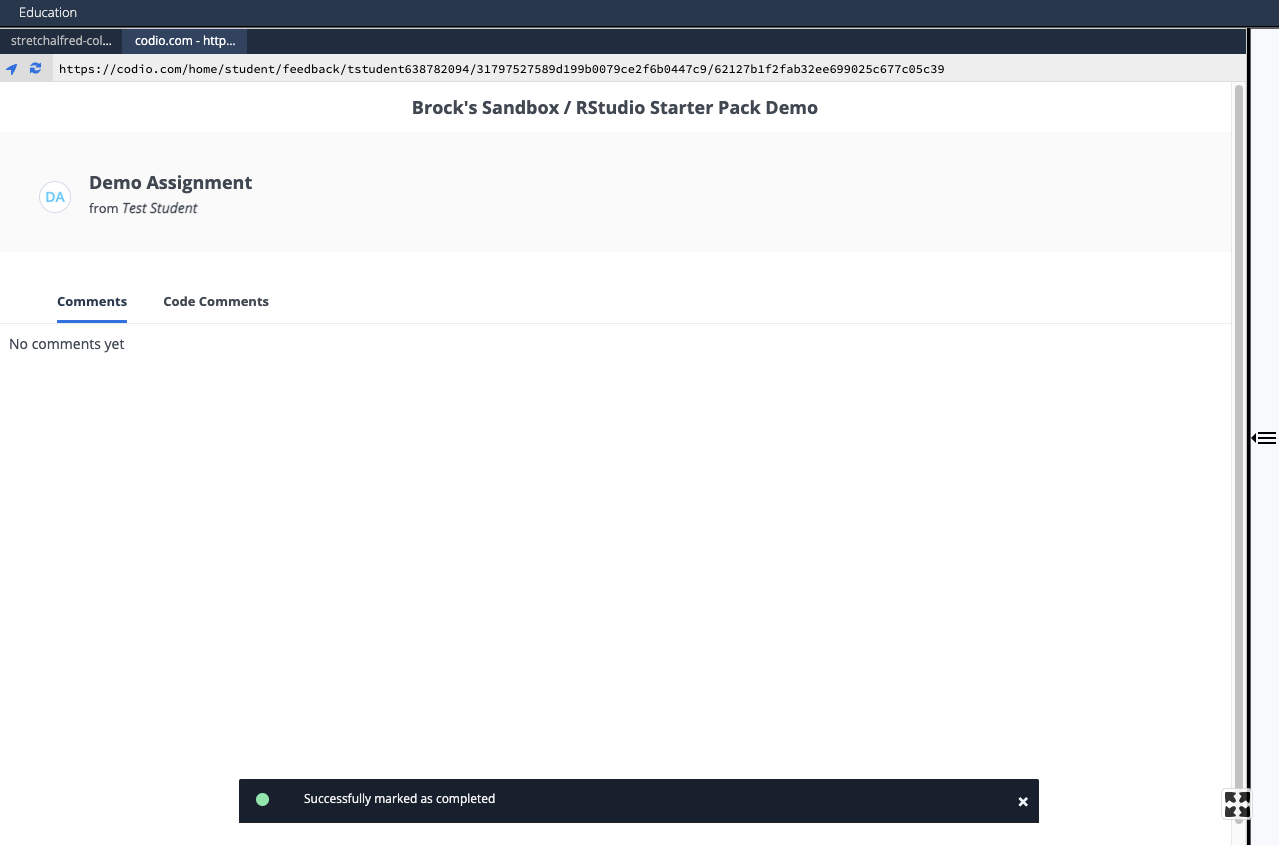
- Enter any solution code and run all cells to make sure no errors or warnings are raised
- Grade the Test Student submission (in teacher view after leaving Test Student view)
- Find the Test Student submission, click the three vertical dots icon, and select Open the project
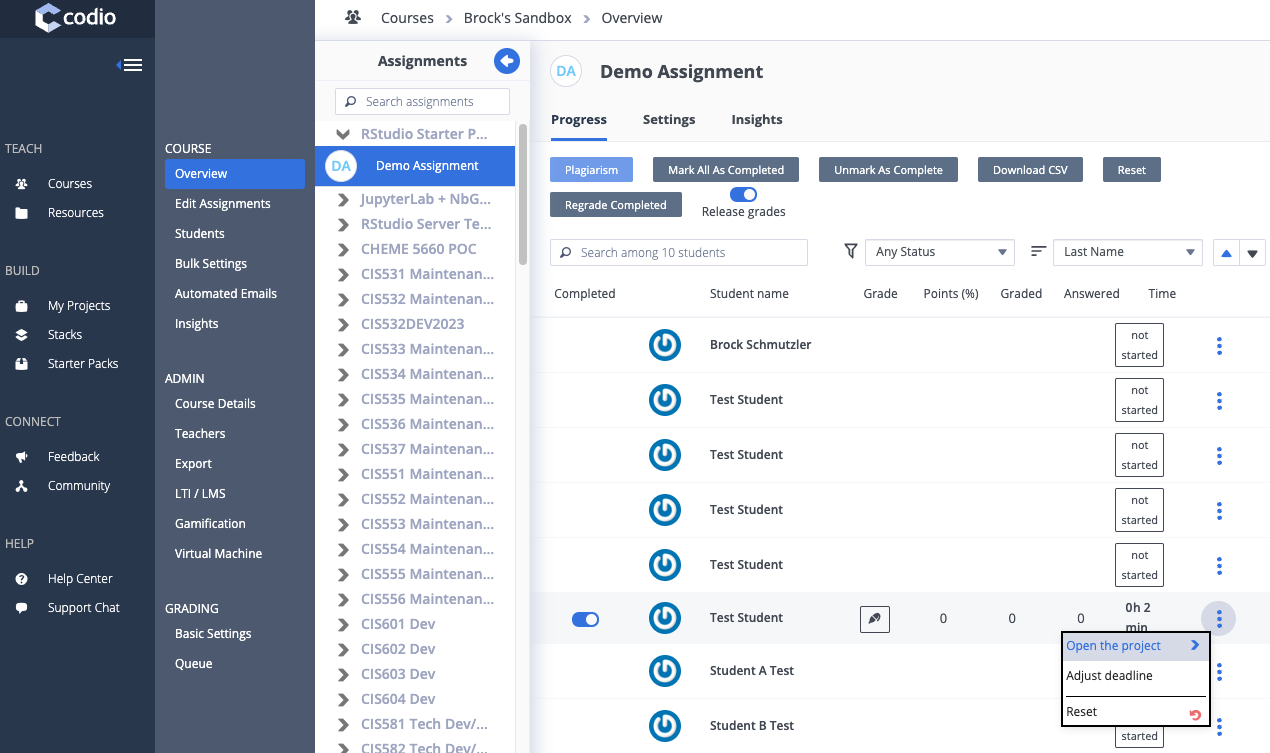
- Click the WRITABLE COPY (sic) button in the upper-right corner of the opened project

- Click the GRADING button in the upper-right corner of the writeable copy
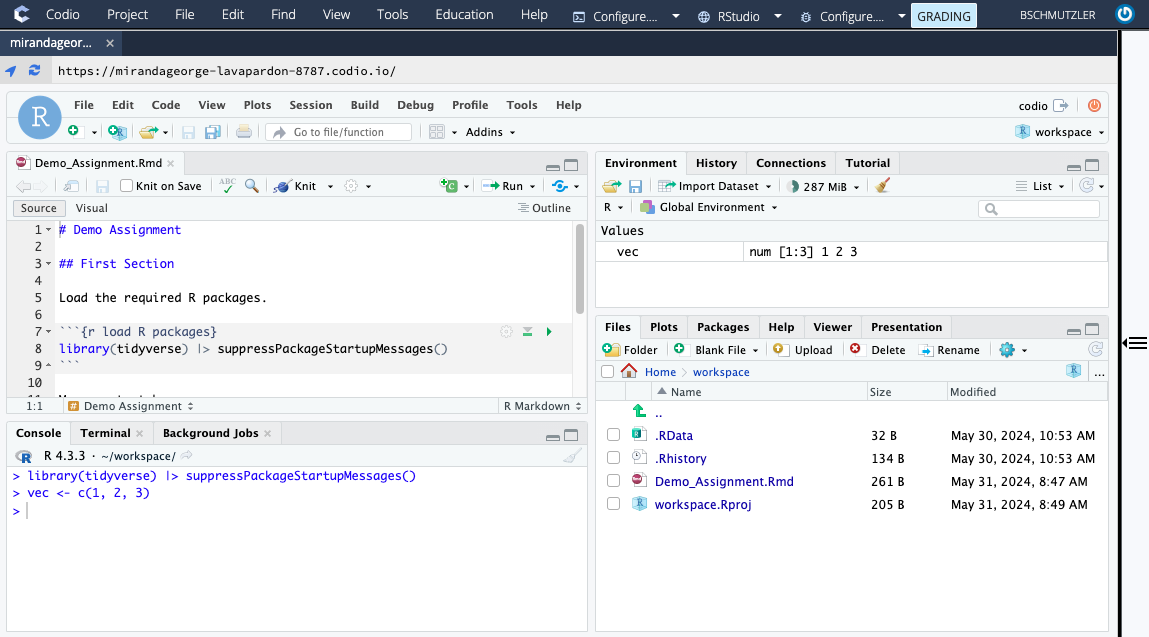
- Click the Add Grade button in the GRADE COMPONENTS section
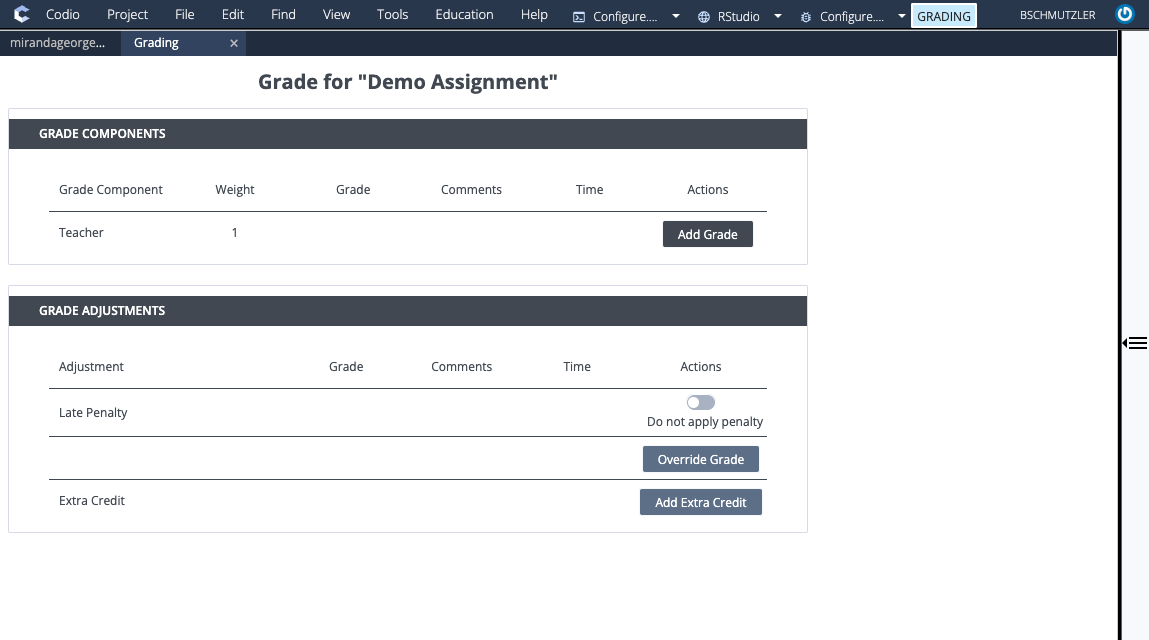
- Enter the grade as a percentage and click Done (see the next step if you are using a rubric)
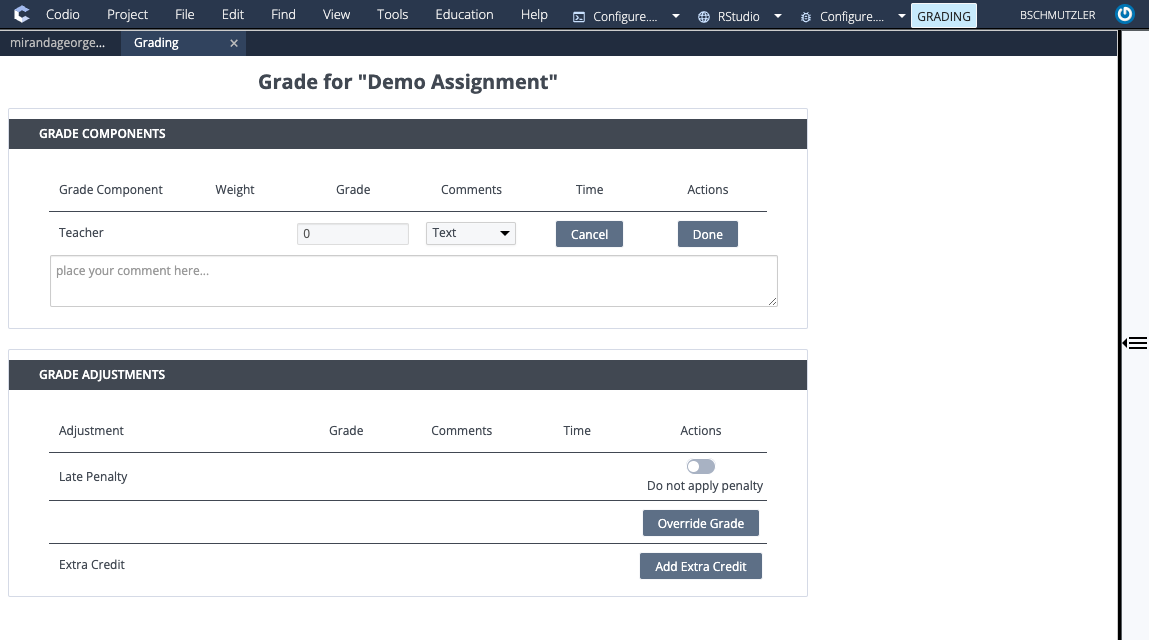
- If you are using a rubric, select rubric boxes, click APPLY, and then click Done
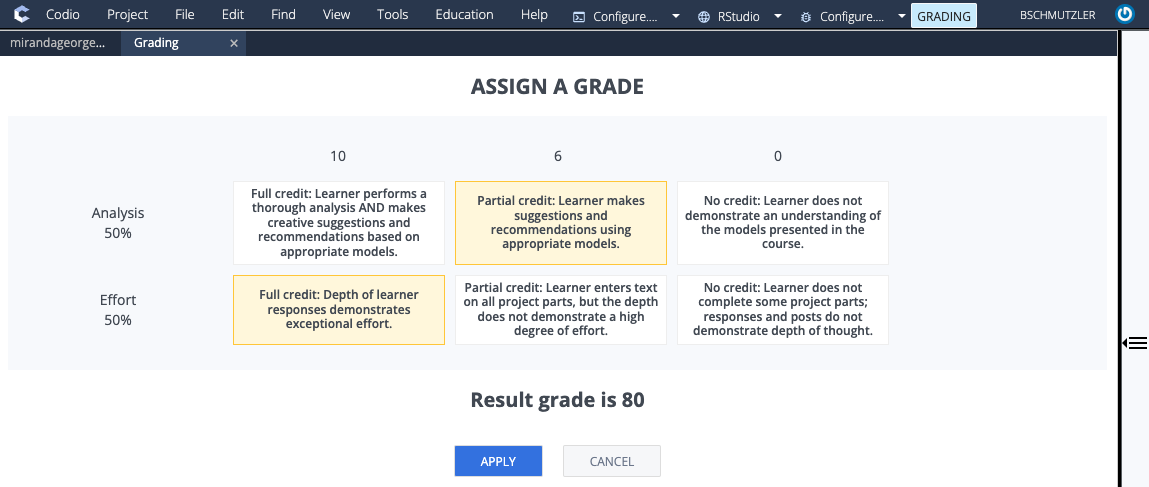
- Find the Test Student submission, click the three vertical dots icon, and select Open the project
Ungraded Canvas Assignments
Follow the steps in this section to set up an ungraded assignment in Canvas with an embedded Codio unit.
- Create a new Canvas page (e.g., Code: Demo Activity)
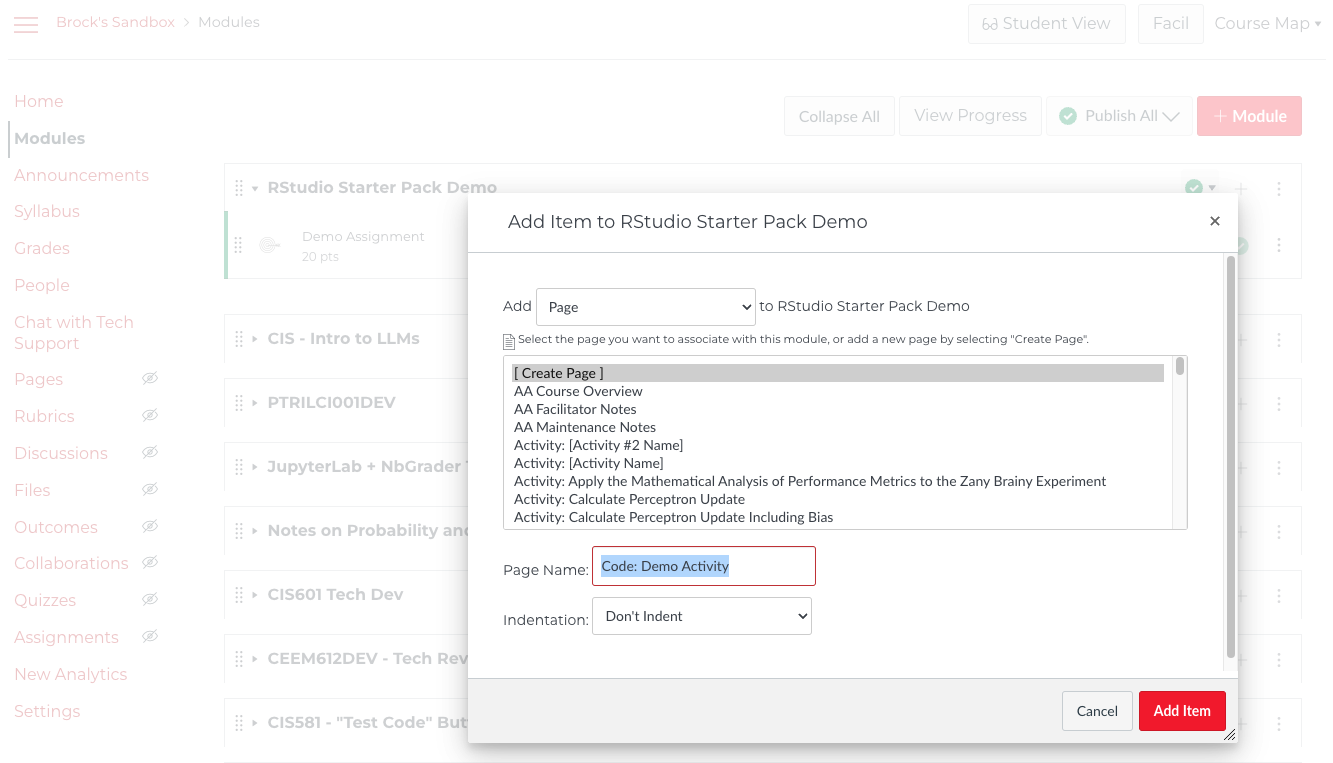
- Edit your new page by going to the plug-in menu and selecting Codio
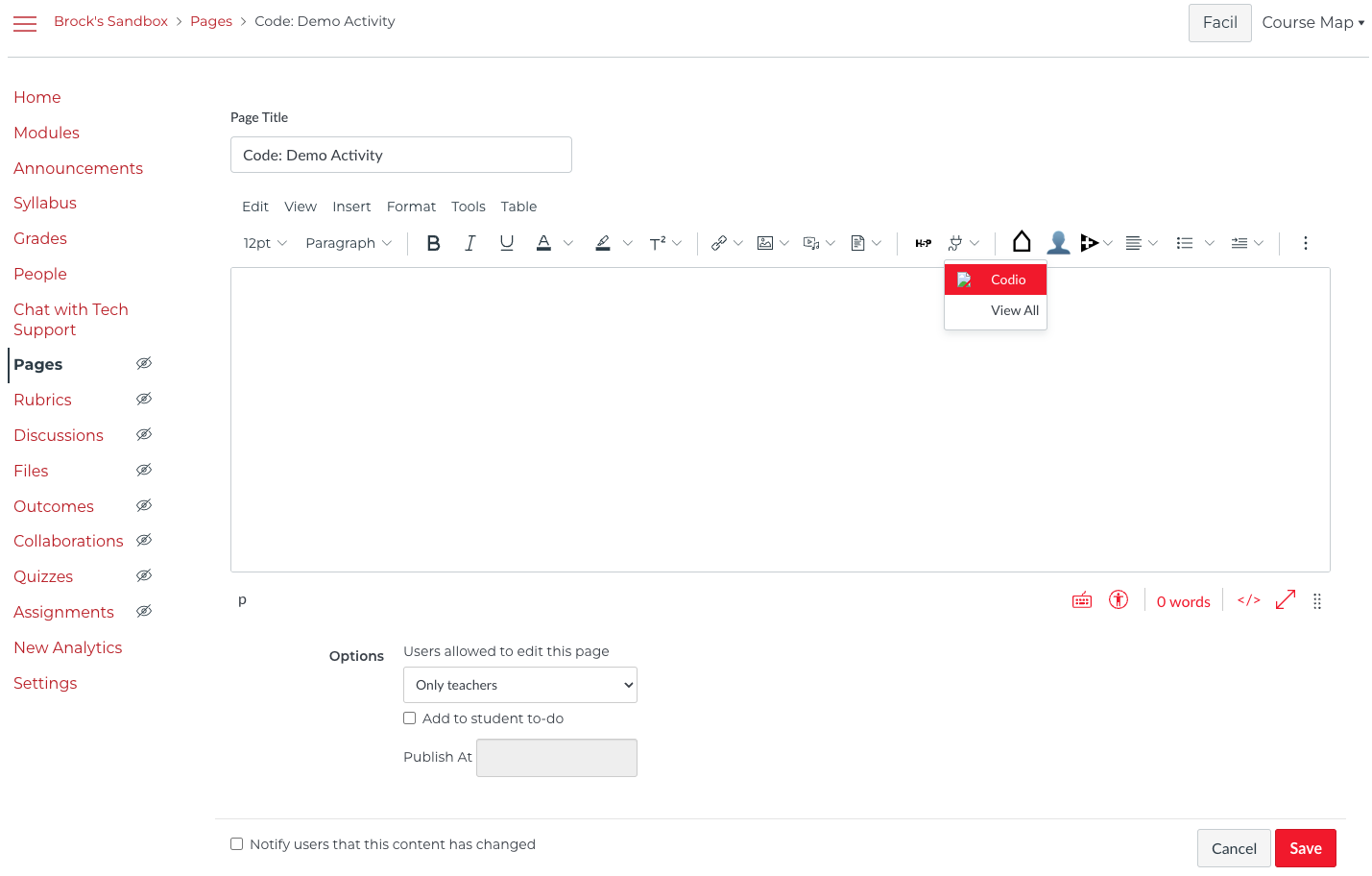
- Select the Codio unit you want to embed in the Canvas page (e.g., Demo Activity)
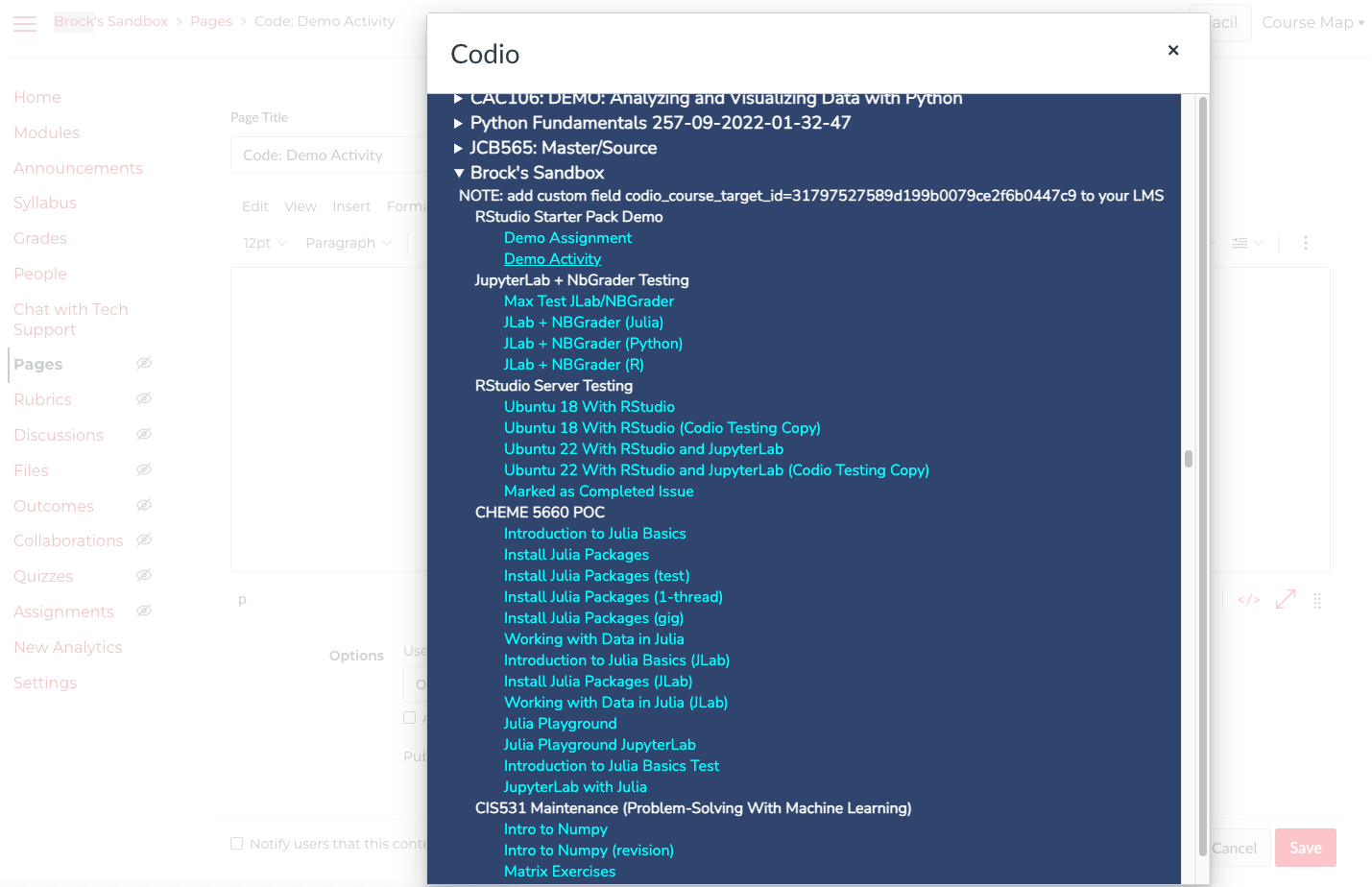
- Go to HTML view and make sure the
widthis100%andheightis800px, and then click Save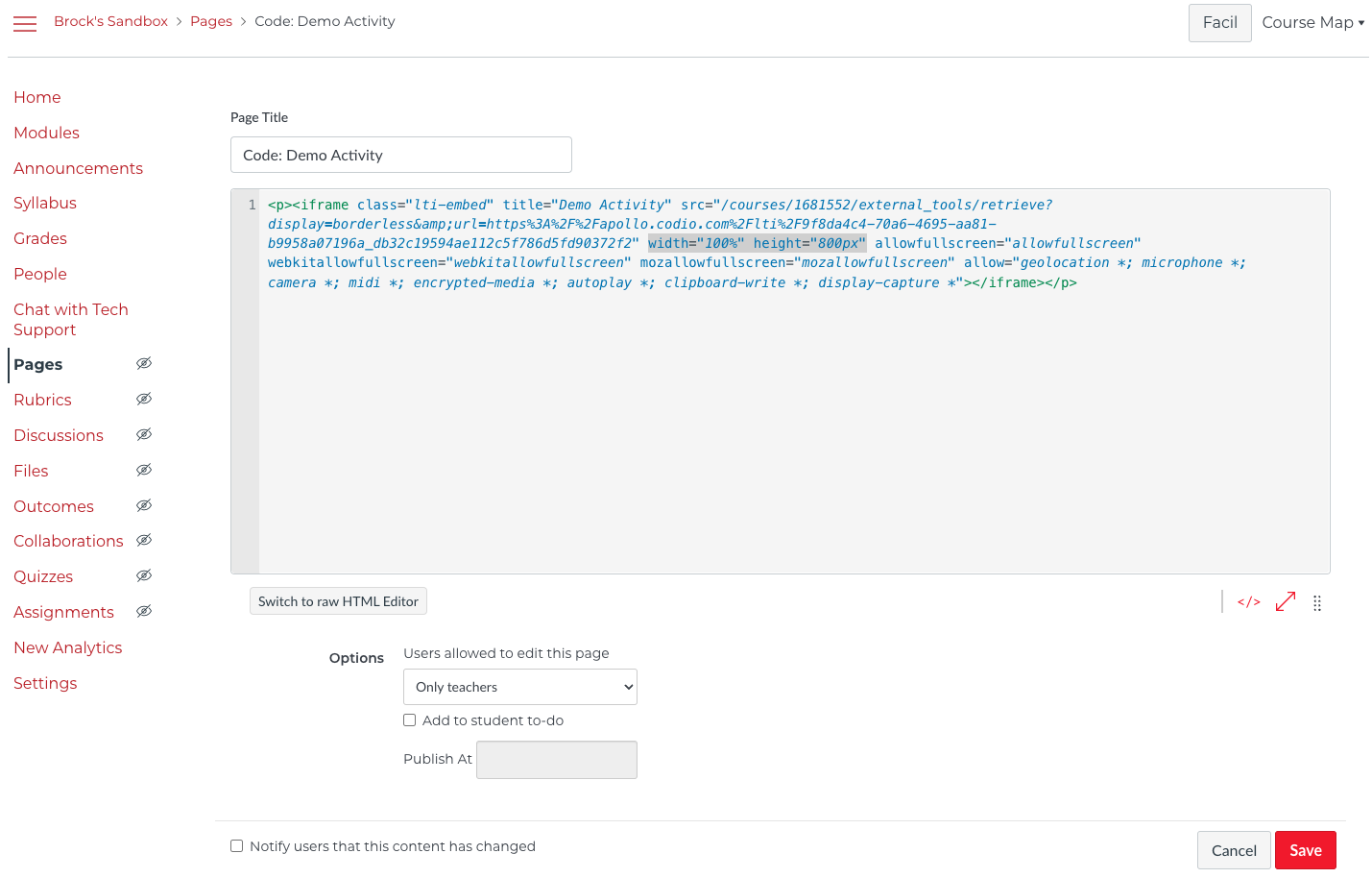
- Go to the Codio unit Settings and make sure grading (teachers, assessments, script) is turned off. If not, toggle them all off and click Save Changes.
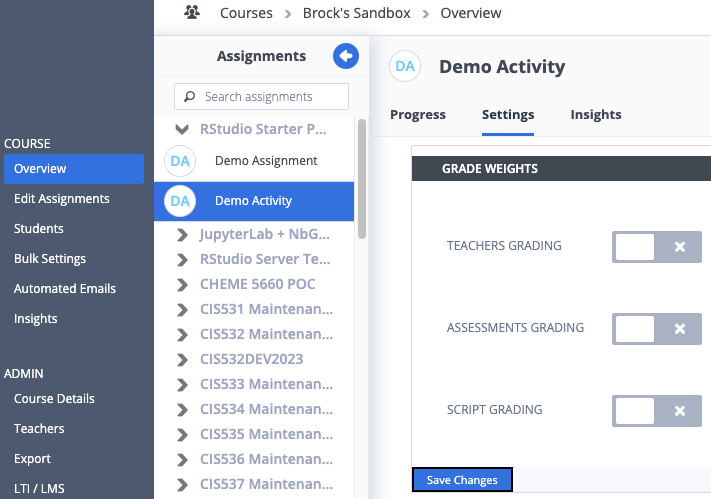
Quick Tips
This section contains a few quick tips on how to keep your R Markdown files easy to read.
Loading Packages
|> suppressPackageStartupMessages() after the library(package) command. This will avoid any potential student confusion regarding confusing, yet benign, package startup messages.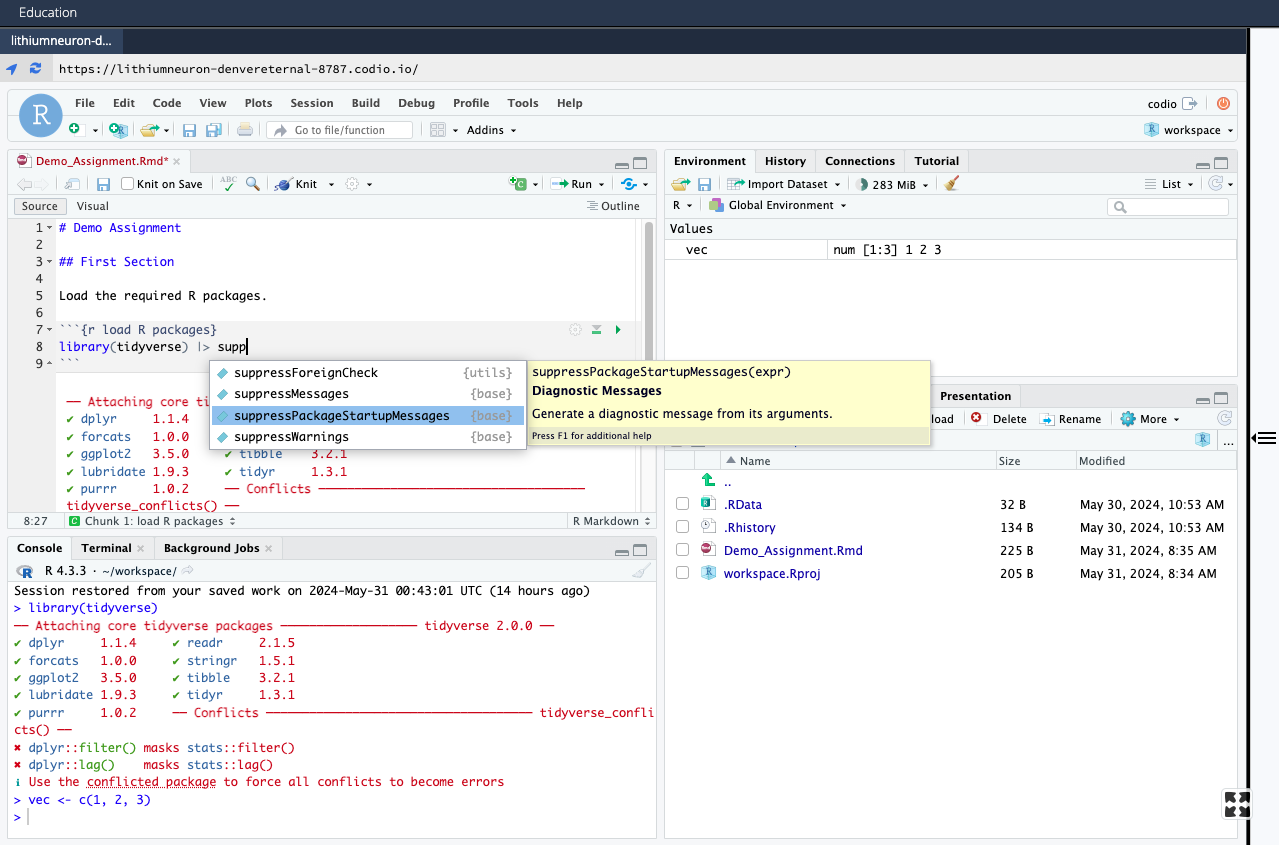
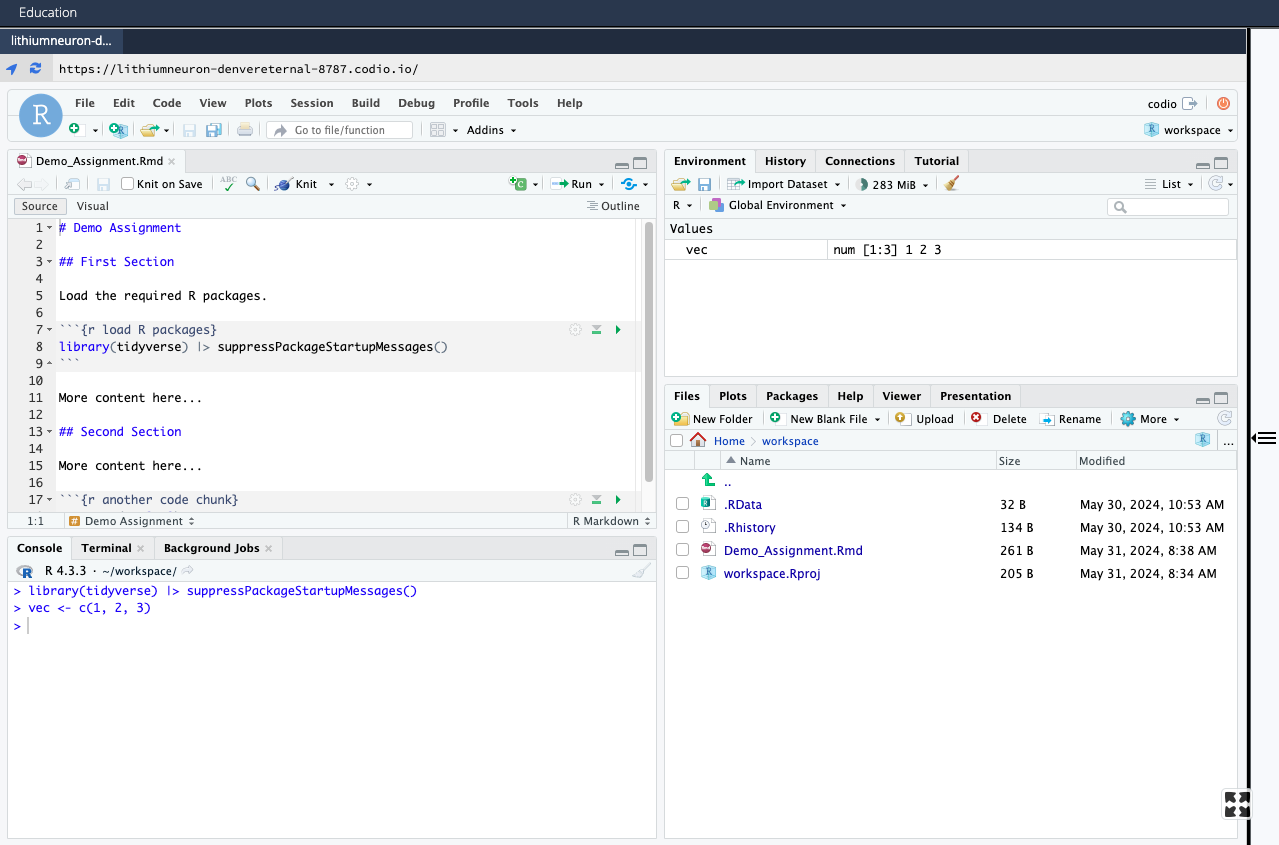
Formatting R Code
To quickly format the R code in an open R Markdown file, select Style active file from the Addins drop-down menu. Doing this will use use the styler package to format the R code according to the tidyverse style guide.
# style: off and # style: on to make styler skip over certain lines of R code, as described in the documentation on ignoring certain lines. You can also control the level of invasiveness by selecting Addins > Set style and set various configuration options (e.g., number of spaces to indent).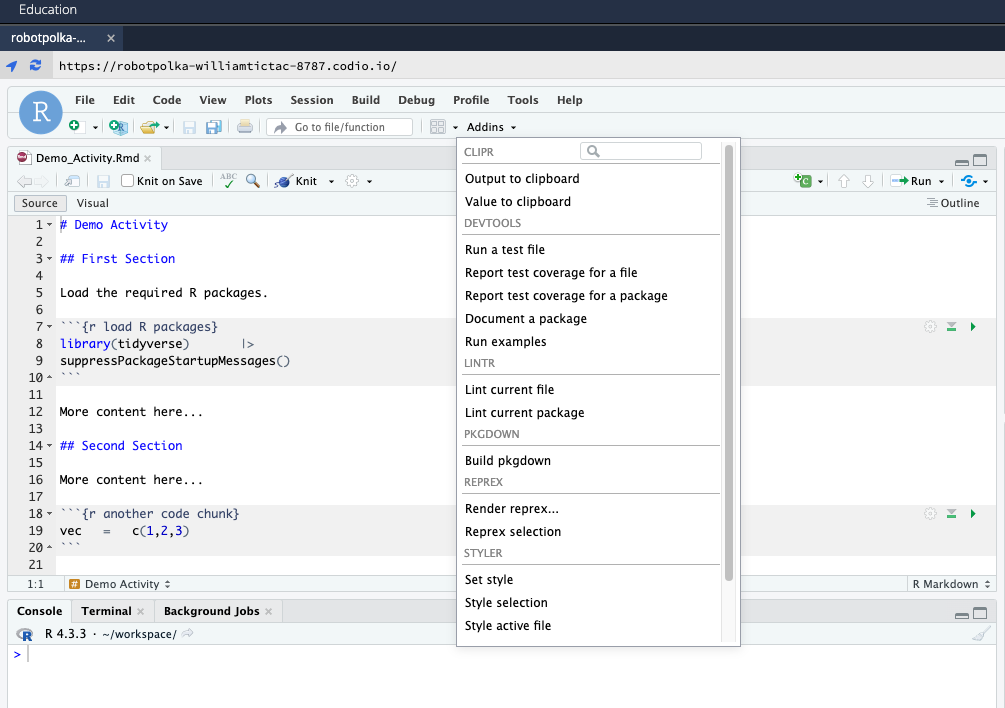
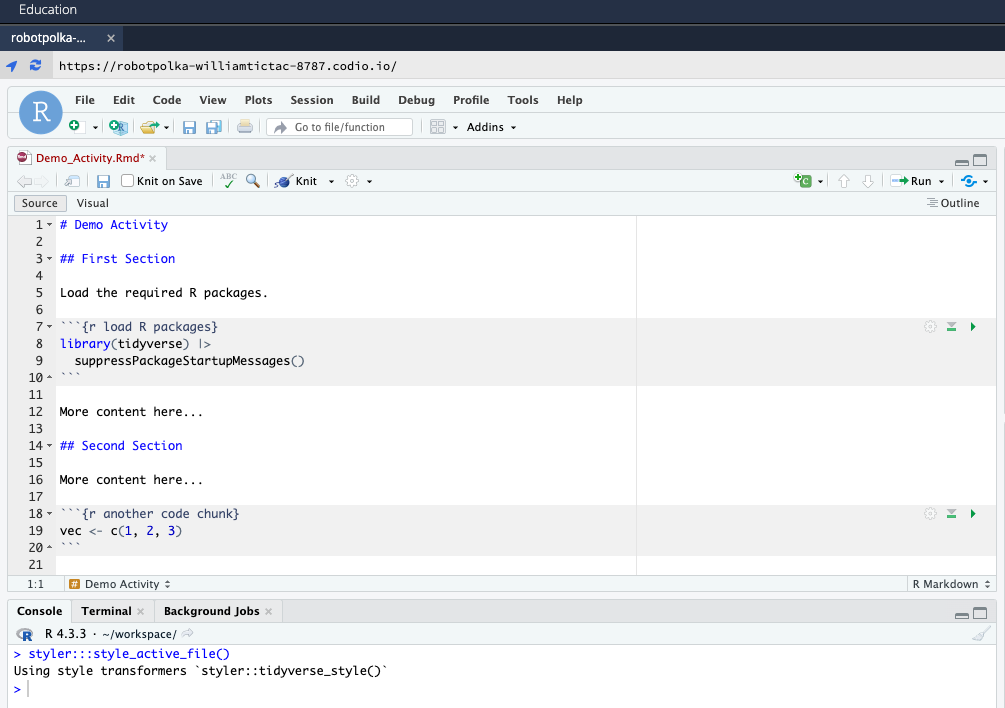
Duplicating Assignments
After you have created one Codio assignment using the RStudio Starter Pack, sometimes the easiest way to create more Codio assignments is to duplicate the first one. The following steps walk through this process.
- Click the Duplicate button (copy icon) for the assignment you want to copy (e.g., Demo Assignment)

- Name the copy something different from the original and click Duplicate

- Open the duplicated assignment (e.g., Second Demo Assignment)
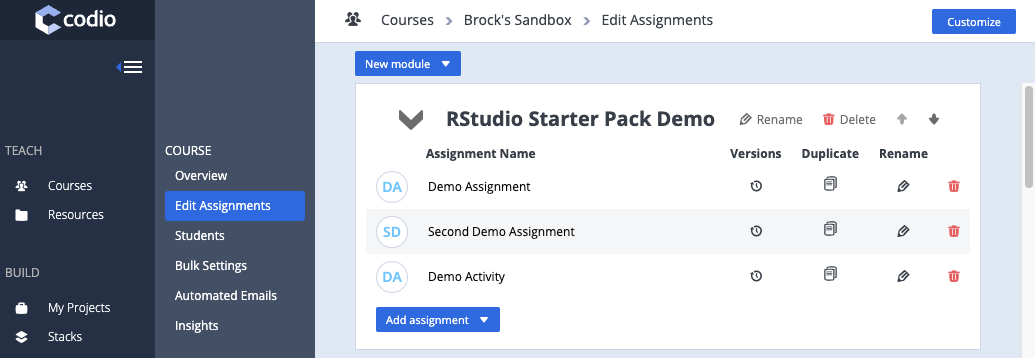
- Right-click the name of the R Markdown file to rename it (e.g.,
Second_Demo_Assignment.Rmd)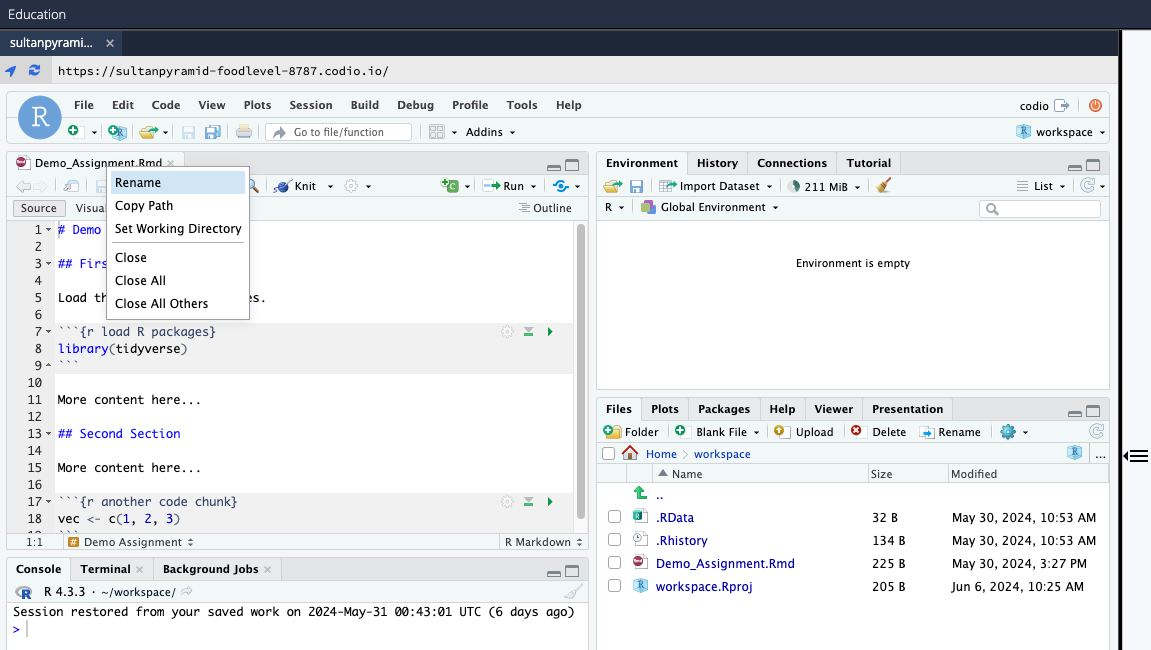
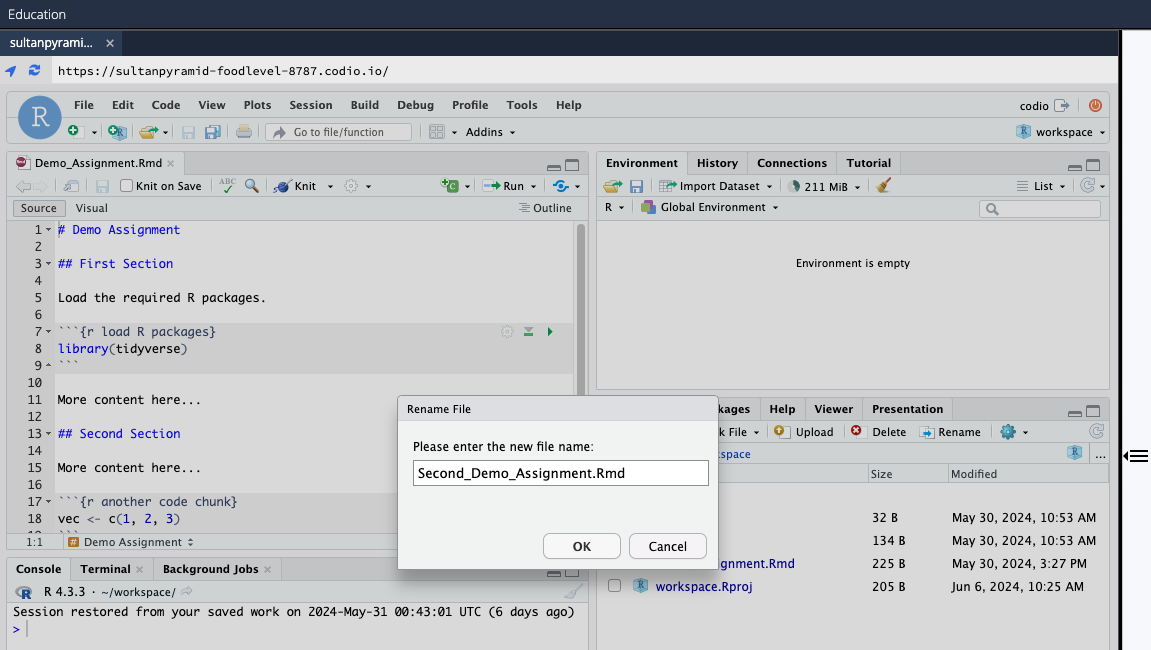
- Save changes to the renamed R Markdown file (click the disk icon, press
command+S, or select File > Save)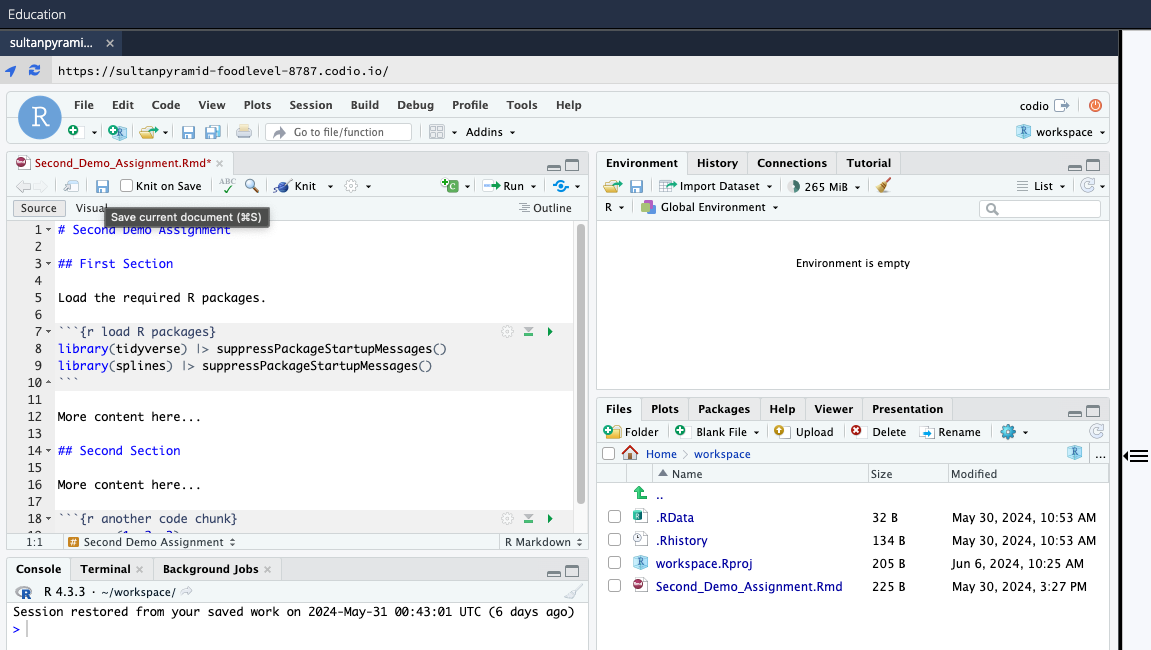
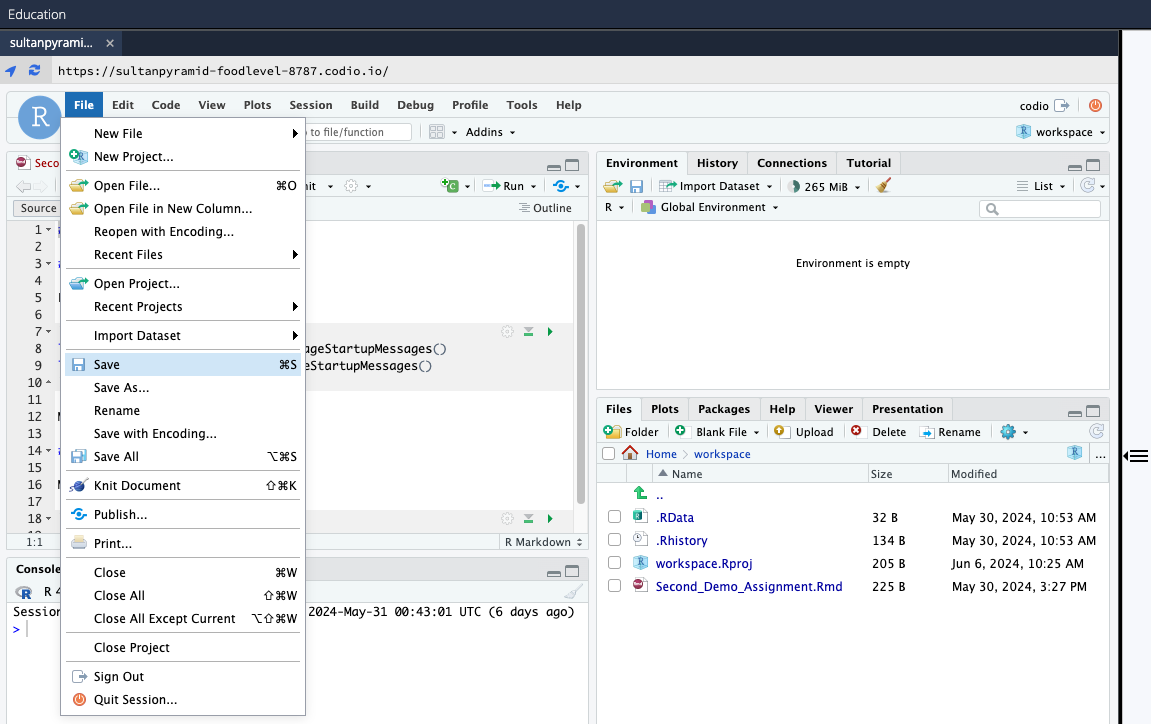
- Expand the right sidebar guide and click the Edit button in the upper-right corner
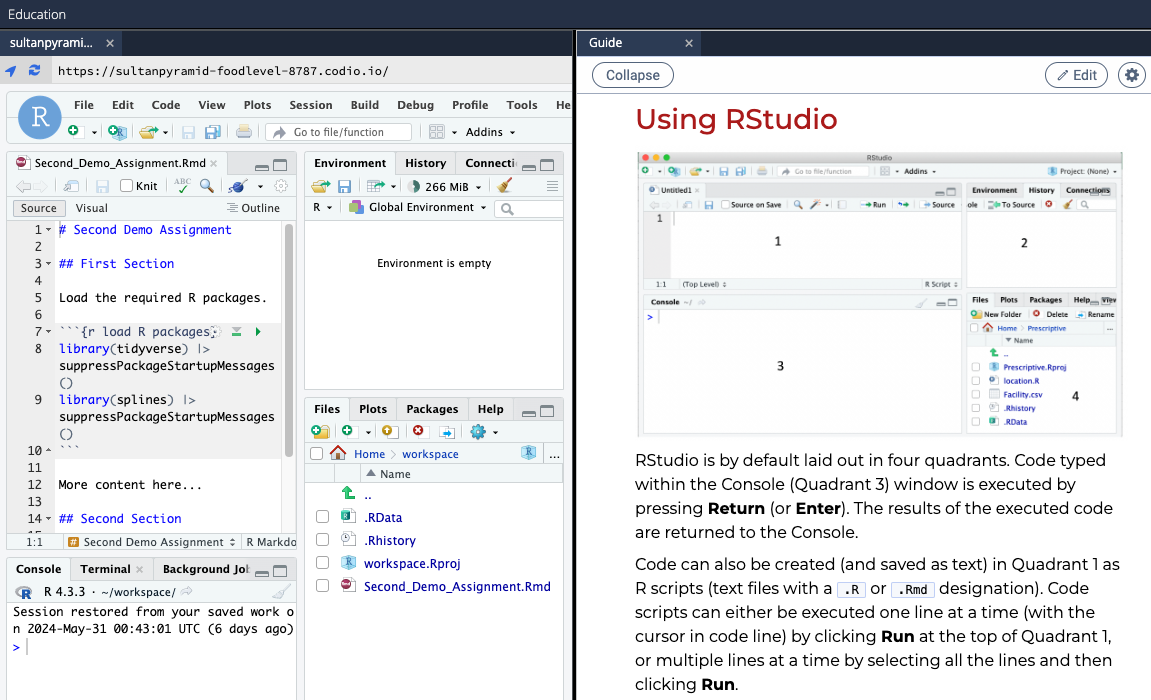
- Delete the old assignment folder from
.R.proj.user/shared/notebooksand then publish